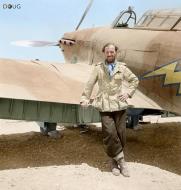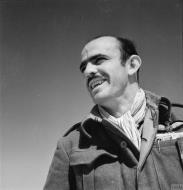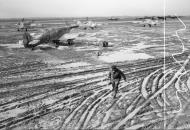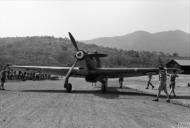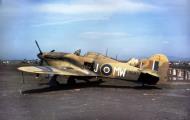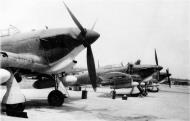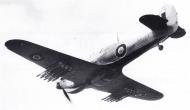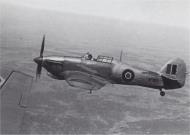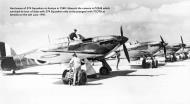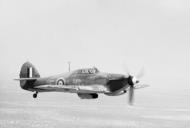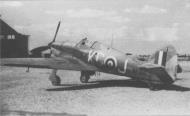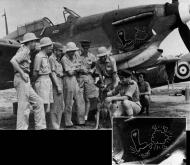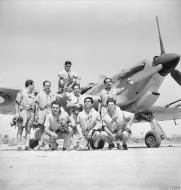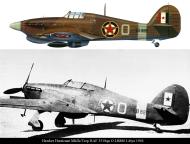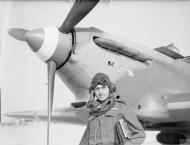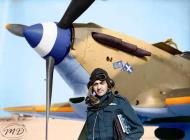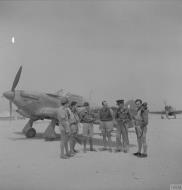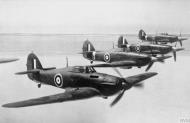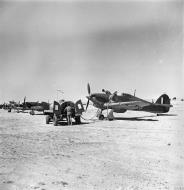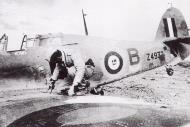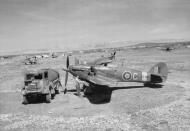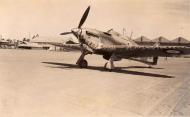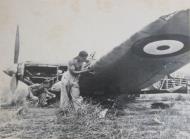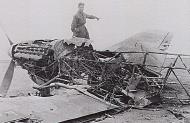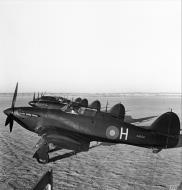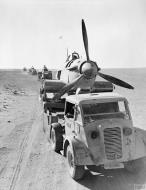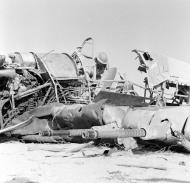Hawker Hurricane photographic information
Photo's 01-02: A burned-out Hurricane found at Larissa-Nord by I.(J)/LG2. At the start of the Greek campaign, 33, 80 and 112 Squadrons, which had he en sent to support the British Expeditionary Force, were equipped with Gladiators. They were later replaced by Hurricanes hut for a while the few remaining Gladiators were retained and operated together with the Hurricanes. In Greece, the RAP found the nimble Italian CR.42s, an example of which may be seen on the far left of the photograph (BELOW) taken on Argos airfield after the British retreat. The CR.42 was much more manoeuvrable than the Hurricanes and it was reported that Hurricanes and Gladiators collaborated to deal with them. In theory, the Hurricanes attacked first with the object of winging the CR.42 which was then given the coup de grace by the Gladiators diving from above. It was also found that the 12.7 mm armament of the CR.42 proved disturbing to the rear gunners in Blenheims, the Italian biplane being able to fire at the Blenheims while remaining out of range of the bombers' Vickers or Browning defensive armament.
Hurricane IIb Trop RAF 128Sqn BD897 SLdr Billy Drake and other leaders with Z4484 background Egypt 1941 01
Nightfighter Hurricanes RAF 30Sqn H Z4204 based in Egypt flew night patrols over the Suez Canal IWM 01
Nightfighter Hurricanes RAF 30Sqn M W9291 based in Egypt flew night patrols over the Suez Canal IWM 01
Artwork Hawker Hurricane MkI ANR BR2337 captured ex-Yugoslav AF Monstar 1941 0A
Profile Source: Artwork Hawker Hurricane MkI ANR BR2337 captured ex-Yugoslav AF Monstar 1941 Model Airplane Int 079 2012-02 Page 30-31
Hawker Hurricane Mk.IIc/Trop RAF 30Sqn RSX flown by Sqn. Ldr. S. C. Norris BP588 Benina Libya end of 1942
Profile 0A: Hawker Hurricane Mk.IIc/Trop RAF 30Sqn RS-X flown by Sqn. Ldr. S. C. Norris BP588 Benina, Libya, end of 1942
Artist: © Rolando Ugolini Source: Air Modeller. 16 issue. February - March 2008. ISSN: 1747-177X.
Hawker Hurricane Mk.IIc/Trop RAF 351Sqn O LB886 Libya 1944
Profile 0A: Unit: 351 Sqn (Yugoslavian), RAF Serial: O (LB886) Camouflage: Dark Earth / Middle Stone / Azure Blue, propeller spinner and fuselage stripe - Sky.
Artist: © Seweryn Fleischer Source: "Hurricane in Foreign Service" by Miroslaw Wawrzynski. AJaKS - Ksiazki Militarne. (c) M.Wawrzynski. (c) AJaKS. ISBN 83-914521-0-7
Hawker Hurricane Mk.IId/Trop RAF 6Sqn JVZ BP188 North Africa June 1942
Profile 0A: Hurricane Mk.IId Unit: 6 Sqn RAF Serial: JV-Z (BP188) Shandur, Egypt, Gambut, Libya, June 1942. The anti-tank version.
Artist: © J-M.Guillou Source: Aero Journal No.4, June - July 2008, (c) Aero-Editions, ISSN: 1962-2430.
Hawker Hurricane RAF being rearmed 1940
Photo 01: With its armament closely grouped in each wing, the impact of a burst from all eight guns was likened to a five-ton lorry hitting a brick wall at sixty miles per hour!
Hurricane IIB RAF 128SQn WGF SqnLdr JI Killy Kilmartin BD776 escort from Jeswang to Hastings Sierra Leone IWM CM2527
Photo: Squadron Leader J I "Killy" Kilmartin, commanding the No.128 Squadron RAF Detachment at Jeswang, The Gambia, escorting a Douglas DC-3 of Pan-American World Airways during a flight from Jeswang to Hastings, Sierra Leone, in Hawker Hurricane Mark IIB, BD776 'WG-F'. Kilmartin was in the process of assuming overall command of 128 Squadron from Squadron Leader Billy Drake at the time.
Source: IWM CM 2527 https://www.iwm.org.uk/collections/item/object/205208916
Hawker Hurricane IIb Trop RAF 128Sqn at Sierra Leone Oct 1941 IWM CM2533
Photo: Groundcrew wheel a Hawker Hurricane Mark IIB of No. 128 Squadron RAF onto the main runway at Hastings, Sierra Leone, for take off. 128 Squadron was based in Sierra Leone between October 1941 and March 1943 in order to defend the ports and bases of British West Africa from incursions by Vichy French aircraft.
Source: IWM CM 2533 https://www.iwm.org.uk/collections/item/object/205208917
BATTLE OF NORTH AFRICA
The situation in the Mediterranean area, Where England is employing superior forces against our allies, requires that Germany should assist for reasons of strategy, politics, and psychology.
I therefore order 'as follows:
- Commander-in-Chief Army will provide covering forces sufficient to render valuable service to our allies in the defence of Tripolitania, particularly against British arrmoured divisions. Special orders for the composition of this force will follow.
- X Fliegerkorps will continue to operate from Sicily. Its chief task will be to attack British naval forces and British sea communications "between the Western and Eastern Mediterranean.
In addition, by use of intermediate airfields in Tripolitaania conditions will be achieved for immediate support of the Graziani Army group by means of attack on British port facilities and bases on the coast of Western Egypt and in Cyrenaica...
Extract from Hitler's War Directive No 22:
German Support for battles in the Mediterranean Area.
11 January 1941
A time line of the historic events that followed Hitlers Order.
1940
* 10 June: The Kingdom of Italy declares war upon France and the United Kingdom. [1]
* 14 June: British forces cross from Egypt into Libya and capture Fort Capuzzo. [2]
* 16 June: The first tank battle of the North African Campaign takes place, the "Battle of Girba" [2]
* 13 September: Italian forces invade Egypt from Libya
* 16 September: Italian forces establish front east of Sidi Barrani
* 9 December: British and Indian forces launch Operation Compass with the Battle of Marmarica (Battle of the camps)
* 9 December: Indian forces capture Nibeiwa with cover from British artillery
* 9 December: British tanks and Indian troops overrun Tummar West followed by Tummar East
* 10 December: Indian forces capture Sidi Barrani with support from British artillery
* 11 December: British armored forces arrived in Sofafi, but Libyan and Italian divisions had escaped
* 16 December: Sollum captured by Allies1941
* 5 January: Bardia captured by British and Australian force
* 22 January: Tobruk captured by British and Australian force
* 30 January : Australians capture Derna, Libya
* 5 February: Beda Fomm captured by British
* 6 February ;
o Fall of Benghazi to the Western Desert Force.
o Lieutenant-General Erwin Rommel is appointed commander of Afrika Korps.
* 7 February: Italian Tenth Army surrenders
* 9 February: Churchill orders halt to British and Australian advance at El Agheila to allow withdrawal of troops to Greece
* 14 February: First units of the Afrika Korps under Erwin Rommel start to arrive in Libya during Operation Sonnenblume
* 24 March Allied forces at El Agheila defeated; Erwin Rommel starts his advance
* 3 April: Benghazi captured by Axis
* 6 April: British 3rd Armored Brigade is captured in Derna
* 8 April: British, Indian and Australian forces captured at Mechili
* 10 April: Siege of Tobruk begins with Australian, British and Indian forces defending
* 15 April: British forces are pushed back to Sollum on Egyptian border with Libya
* 30 April: Australian forces lose a small part of their positions in Tobruk during the Battle of Salient, roughly a 6th of Tobruk is now held by Germans
* 3 May: Australian forces counter attack in Tobruk unsuccessfully
* 15 May: British troops launch Operation Brevity to gain more territory from which to launch Operation Battleaxe later in the year.[3]
* 16 May: Italian forces attack Australian forces in Tobruk forcing them to withdraw[citation needed]
* 16 May: Operation Brevity called off. Allied forces fall back onto the Halfaya Pass, captured the previous day.[4]
* 26 May: German forces launch Operation Skorpion and move up to Halfaya Pass
* 27 May: German forces recapture Halfaya Pass; British troops are forced to withdraw.[5]
* 15 June: British and Indian troops launch unsuccessful Operation Battleaxe
* 5 July: Auchinleck replaces Wavell as C-in-C Middle East Command
* 15 August: German Panzer Group Afrika activated with Rommel in Command
* 1 October: 5th Light Division redesignated 21st Panzer Division
* 18 November: Auchinleck's offensive (Operation Crusader) begins with British, Indian, South African and New Zealander forces
* 21 November: British armored division defeated at Sidi Rezegh and withdraws
* 22 November:
o New Zealand forces attack Bir Ghirba but are unsuccessful
o Indian forces capture Sidi Omar
* 23 November: New Zealand forces capitalize on Indian advances to wreck Afrika Korps HQ at Bir el Chleta
* 23 November:
o Rommell launches Panzer attacks on the British XXX Corps, but face resistance from SA, NZ and British forces
o British and NZ forces withdraw towards Bir el Gubi
* 25 November:
o Panzer attack on Indian forces at Sidi Omar is repulsed
o In the second attack in the evening, Indian forces destroy the 5th Panzer Division
* 26 November: Ritchie replaces Cunningham as commander Eighth Army
* 27 November: New Zealand troops at Sidi Azeiz defeated by overwhelming advance of Panzers and German infantry
* 28 November: 15th Panzer despite being outnumbered 2:1 force British tanks to retreat exposing the New Zealand forces at Ed Duda on the Tobruk by-pass
* 1 December: New Zealand troops in Sidi Rezegh suffer heavy casualties by Panzers
* 3 December:
o German infantry suffers heavy defeat at the hand of New Zealand forces on the Bardia road near Menastir
o German forces suffer losses against Indian forces and forced to withdraw at Capuzzo (Trigh Capuzzo)
* 4 December:
o NZ forces repulse German attack on Ed Duda
o Indian forces face attrition in an uphill attempt to capture Point 174 against entrenched Italian forces without artillery support
* 7 December: Tobruk siege relieved by 8th Army consisting of British, Indian, New Zealander and South African forces
* 13 December:
o 8th Army attacks Gazala line
o NZ forces stopped at Alem Hamza
o Indian forces take Point 204
o Indian infantry face Afrika Korps and against heavy odds destroy 15 of 39 Panzers
* 14 December: Indian troops repel repeated Panzer attacks on Point 204
* 15 December: German advance overruns British forces en route to Point 204, but Indian forces at Point 204 hold on
* 16 December: Rommel facing reduced Panzer numbers orders withdrawal from the Gazala line
* 24 December British forces capture Benghazi
* 25 December: Agedabia reached by the Allies
* 27 December: Rommel inflicts heavy damage on British armour who have to withdraw allowing Rommel to fall back to El Agheila
* 31 December: Front lines return to El Agheila1942
* 21 January: Rommel's second offensive begins
* 23 January: Agedabia captured by Axis forces
* 29 January: Benghazi captured by Axis forces
* 4 February: Front line established between Gazala and Bir Hakeim
* 26 May: Axis forces assault the Gazala line, the Battle of Gazala and Battle of Bir Hakeim begins
* 11 June: Axis forces begin offensive from "the Cauldron" position
* 13 June: "Black Sunday". Axis inflicts heavy defeat on British armoured divisions
* 21 June: Tobruk captured by Axis forces
* 30 June: Axis reaches El Alamein and attack, the First Battle of El Alamein begins
* 4 July: First Battle of El Alamein continues as Axis digs in and Eighth Army launch series of attacks
* 31 July: Auchinleck calls off offensive activities to allow Eighth Army to regroup and resupply
* 13 August: Alexander and Montgomery take command respectively of Middle East Command and Eighth Army
* 30 August: Rommel launches unsuccessful Battle of Alam el Halfa
* 23 October: Montgomery launches Operation Lightfoot starting the Second Battle of El Alamein
* 5 November: Axis lines at El Alamein broken
* 8 November: Operation Torch is launched under the command of General Eisenhower, Allied forces land in Morocco and Algeria.
* 9 November: Sidi Barani captured by Eighth Army
* 13 November: Tobruk captured by Eighth Army
* 15 November: British forces capture Derna.
* 17 November: First Army (Operation Torch's Eastern Task Force) and Axis meet at Djebel Abiod in Tunisia
* 20 November: Benghazi captured by Eighth Army
* 27 November: First Army advance halted between Terbourba and Djedeida, 12 miles from Tunis, by Axis counterattack
* 10 December: First Army front line pushed back to defensive positions east of Medjez el Bab
* 22 December: First Army starts three day offensive towards Tebourba which fails
* 25 December: Sirte captured by Eighth Army1943
* 23 January: Tripoli captured by British Eighth Army
* 30 January: Axis forces capture Faïd pass in central Tunisia
* 4 February: Axis forces in Libya retreat to Tunisian border south of the Mareth Line
* 14 February: Axis advance from Faïd to launch Battle of Sidi Bou Zid and enter Sbeitla two days later
* 19 February: Battle of Kasserine Pass launched by Axis forces
* 6 March: Axis launch Operation Capri against Eighth Army at Medenine but lose 55 tanks
* 19 March: Eighth Army launches Operation Pugilist
* 16 March: Battle of Mareth begins. [6]
* 23 March: U.S. II Corps emerge from Kasserine to match the Axis at Battle of El Guettar. Battle of Mareth ends.[6]
* 26 March: Eighth Army launch Operation Supercharge II outflanking and making the Axis position at Mareth untenable. Battle of Tebaga Gap takes place.[7]
* 6 April: Right wing of First Army links with Eighth Army. Battle of Wadi Akarit takes place.
* 22 April: Allied forces launch Operation Vulcan
* 6 May: Allied forces launch Operation Strike [8]
* 7 May: British enter Tunis, Americans enter Bizerte
* 13 May: Axis Powers surrender in Tunisia.The Background
For some time prior to the outbreak of war in Europe in 1939, the Italian dictator, Benito Mussolini, had coveted the British and French possessions in North and East Africa. Their capture would enable him to link the colony of Libya, which had been an Italian possession since 1912, with Eritrea and Abyssinia, the latter having been invaded by Italy in 1935.
Mussolini looked upon the German victories in Europe during the first half of 1940 with envy and, unable to resist the opportunity to take a share of the Nazi successes, declared war on Britain and France on 10 June 1940. The problem was that although Italy possessed a large and modern navy, its army was badly led and poorly equipped, and much of its 3,000 strong air force, the Regia Aeronautica, was largely furnished with obsolete aircraft.
Italy's first offensive action was to mount a futile and inglorious offensive on the western Alpine front of France, which was to result in the first resounding demonstration of the Italian Army's unreadiness for combat. A day later, on 11 June, units from the Regia Aeronautica launched their first attack on the strategically important island of Malta, a Royal Navy base in the centre of the Mediterranean. At the same time, RAF Blenheims attacked Italian aircraft on the ground at EI Adem, an important airfield in Italian-owned Libya guarding the approaches to the port of Tobruk. Fiat CR.42s from the Regia Aeronautica claimed to have shot down three Blenheims, but several Italian aircraft were also destroyed.
During the next few months, Italian air and ground forces skirmished inconclusively on the Libyan-Egyptian border with those of Britain and it was not until 13 September that Marshall Rodolfo Graziani, commander in chief of Italian forces in North Africa, felt ready to launch a major operation into Egypt. Advancing across the border, the Italians quickly took Sollum and then moved forward to Sidi Barrani where they dug in.
On the ground, there was then another period of inactivity with the two armies facing each other along a north-south line just east of Sidi Barrani. In the air, however, there was considerable activity with some major clashes between the RAF and the Regia Aeronautica. Finally, on 9 December, British and Commonwealth forces under General Sir Archibald Wave II launched a major counter-attack, supported by increasing numbers of Hurricane fighters and Blenheim bombers. By the evening of tHe-11th, British and Indian troops had re-captured Sidi Barrani and taken 38,000 Italian prisoners, 237 guns and 73 tanks for the loss of only 624 killed, wounded or missing. Four days later, Italian forces were expelled from Egypt, and on 3 January Australian troops launched an attack on Bardia on the Libyan border which they quickly overran. On 22 January the fortified port of Tobruk also fell to the Australians, followed by Derna at the end of the month.
Meanwhile, constant air battles were taking place over Malta. Initially the defence of the island was limited to four Gladiator biplanes and a small number of anti-aircraft guns. Early in August 1940, 12 Hurricanes were flown to Malta from the aircraft carrier HMS Argus, but this still left the defending air forces woefully inferior in number to the large quantities of Italian aircraft based in Sicily. On 5 September, Italian units which had just re-equipped with German Ju-87 B dive-bombers, struck at the island for the first time. Two days later, ten SM.79s bombed Valetta and, on 18 September, SM.79s escorted by C. 200s on their first operational sortie, bombed Hal Far airfield. There were only two more raids in October, but on 8 November, five SM.79s attacked the seaplane base at Kalafrana.
Despite this harassment, on 9 November the British aircraft carrier HMS Ark Royal was able to launch an attack on Sardinia, providing diversionary cover for a large-scale assault on the Italian fleet in Taranto harbor on the night of 11/12 November. Following reconnaissance by Malta-based Marylands and Sunderlands, an attack by 21 Swordfish aircraft from the carrier HMS Illustrious crippled three Italian battleships and damaged several cruisers. It was a blow from which the Italian fleet took a long time to recover.
Fifteen SM.79s bombed Malta on 23 November and only one raid was flown against the island in December. During its seven months of operations against Malta, the Regia Aeronautica had lost a total of 23 bombers and 12 fighters, with a further 187 bombers and seven fighters damaged.
The severe reverses suffered by Italian forces, not only in North Africa and Taranto, but also in Greece, threw the Italian leadership into near chaos and was an enormous embarrassment and a plight which Germany could not ignore. Late in December, although unwilling to become directly involved in the Middle East, Hitler ordered the transfer of a small air fleet, the X. Fliegerkorps under Generalleutnant Hans Geisler, from Norway to Sicily, and two Panzer divisions were ordered to North Africa. Shortly afterwards, 65 Ju-52/3m transports left Germany for Foggia in southern Italy to ready the bases for operations in January 1941. News that a large British convoy was on its way to Alexandria via Malta hastened these preparations and on 9 January reconnaissance showed that the British convoy, spearheaded by the aircraft carrier Illustrious and the battleships Warspite and Valiant, was within range of Sicily. The next day the convoy was attacked by 18 He-111s from II./KG26. This strike was unsuccessful, but two hours later 13 Ju-87s from II./St.G2 managed to hit Illustrious with six 500kg bombs and all but sank the carrier. She managed to limp towards Valetta harbor under constant attack by the Luftwaffe. Further attacks on the carrier by X. Fliegerkorps' aircraft followed, but not without loss to the German forces. During one particular strike, 2./St.G1 lost all its crews except the Staffelkapitan.
At this time, the only German day fighter unit based in the area was III./ZG 26 equipped with the Bf-110, but soon the decision was taken to transfer a Bf-109E Staffel, 7./JG 26, to Sicily. A 40-man detachment from the unit's ground staff left Wevelgem in Belgium for Italy in Ju-52/3ms on 22 January and were soon joined in Rome by 12 pilots each flying a brand-new Bf-109E-7/N. The 22-year-old Oblt. Joachim Muncheberg, who had already been awarded the Ritterkreuz in September 1940, led the Staffel. Apart from Muncheberg and Oblt. Klaus Mietusch however, 7./JG 26 was made up mainly of inexperienced pilots, 13 of its 'old guard' having been killed during the Battle of Britain.
Luftwaffe Operations Against Malta
"At about 9.1.5, we were ordered to scramble. We climbed to 20,000 ft. We were still climbing over Luqa when six Me 109s screamed down on us out of the sun. We immediately broke away and formed a rather wide circle. Just as I took my place in the circle I saw four more Messerschmitt’s coming down out of the sun. I turned back under them, and they overshot me. I looked round very carefully, but could see nothing, so turned back onto the tail of the nearest Hun who was chasing some Hurricanes in front of him. We were all turning gently to port, so I cut the corner and was slowly closing in on the Hun. I was determined to get him, and must have been concentrating so intently on his movements that, like a fool, I forgot to look in the mirror until it was too late. Suddenly there was a crash in my cockpit - bits and pieces flew everywhere. Instinctively I went into a steep spiral dive, furiously angry that I had been beaten at my own game. My left arm was dripping blood, and when I tried to raise it only the top part moved, the rest hung limply by my side. Everything happened so quickly that I have no very clear recollection of what actually took place."
Diary of Flt. Lt. James MacLachlan, Hurricane pilot with 261 Squadron shot down by Oblt. Joachim Muncheberg of 7./JG 26.
16 February 1941
On 9 February, 7./JG 26 left Italy for its new operational base at Gela in Sicily and flew its first operational sorties over Malta three days later. During these, it claimed the destruction of three
Hurricanes from 261Sqn., one by Muncheberg, and two by Fw. leibing. On 16 February, a Schwarm of Bf-109s from 7./JG 26 flew escort for II./St.G2's Ju-87s attempting to bomb luqa airfield. Eight Hurricanes from 261Sqn. attempted to intercept, but were attacked from above by the Messerschmitts. Three British fighters were shot down, two by Muncheberg (including Maclachlan's mentioned above), for no loss to the Germans.
The Bf-109E-7 IN, powered by tHe-1,175 hp DB601N engine, had a maximum speed of over 570 km/h (354 mph), about 80 km/h (50 mph) faster than the Hurricane I. In addition, JG26's tactics, honed during the Battle of Britain, were far superior. Muncheberg's fighters would wait at high altitude for the Hurricanes to appear, dive on them and then zoom back, avoiding any opportunity in which the British fighters could use their excellent manoeuvrability. lacking similar experience in the Battle of Britain, the RAF pilots were still flying in outdated tight Vee formations, whereas the Germans were using the loose group of four pioneered in Spain and continued ever since.
A major Luftwaffe attack was flown against luqa on 26 February when the airfield was put out of action for 48 hours. 7./JG 26 claimed the destruction of four Hurricanes on this day and damaged three Fairy Fulmars from HMS Illustrious and another Hurricane on 2 March. Three days later, I./JG 27 was escorting a Stuka attack on Hal Far airfield in the south-east of the island and, while en route to Libya, shot down a Hurricane. Two Ketten from 7./JG 26 shot down a Hurricane and a Maryland on 7 March, later strafing S1. Paul's Bay and damaging a Sunderland flying boat. On tHe-10th, most other Luftwaffe units were transferred to North Africa, leaving 7./JG 26 as the largest in Sicily. An attack by the Staffel on Wellingtons five days later led to the destruction of one by Muncheberg and the temporary withdrawal of this type, and the Sunderlands, to North Africa. On 18 March, six of an eventual force of 12 Hurricanes arrived in Malta from North Africa, but seven of the type were claimed destroyed by 7./JG 26 four days later. On the 28th Muncheberg flew his 200th combat sortie, during which he claimed his 33rd victory, another Hurricane.
A temporary respite was given to the hard-pressed people of Malta by the arrival, on 3 April, of 12 of the new Hurricane liAs which were some 20 mph (32 km/h) faster than the old Mk. Is. These had been flown off the aircraft carrier HMS Ark Royal. Then, two days later, 7./JG 26 transferred to Taranto in Italy to support the forthcoming German invasion of Yugoslavia. It returned to Gela on the 8th, flying sorties against Malta in company with III./ZG26 and a Stuka Gruppe. On 27 April, Malta received another 23 Hurricanes which flew off from HMS Ark Royal. 7./JG 26 shot up and destroyed a Sunderland which had landed after escorting the first flight of seven Hurricanes.
On 5 May, 7./JG 26 was temporarily joined at Gela by III./JG 27 under Hptm. Max Dobislav, and the next day the two units flew as escort for a He-111 attack on Malta. During this, Oblt. Graf Erbo von Kageneck, Staffelkapitan of 9./JG 27, shot down a Hurricane, with two more falling to the guns of Oblt. Muncheberg. Muncheberg's success brought his total number of victories to 40 for which he was awarded the Eichenlaub to the Ritterkreuz on 7 May.
Four days later the forces of X. Fliegerkorps returned to Sicily in preparation for a full-scale attack on Malta and Allied shipping. At this time the Luftwaffe possessed a total of 60 operational Bf-109s from 7./JG 26 and III./JG 27. Next day, in an attempt to counter this threat, the one RAF fighter unit in Malta, 261Sqn., equipped with Hurricanes, was divided into two, one half, equipped with Hurricane lis, becoming 185Sqn. On 13 May, von Kageneck shot down a Hurricane of 261Sqn. followed by another aircraft from 185Sqn. on each of the next two days. He shot down another Hurricane on 20 May to register his fourth victory over Malta but, on that day, the unit returned to Germany. At the same time, X. Fliegerkorps returned to southern Greece to spearhead the invasion of Crete. This again left 7./JG 26 as the only Luftwaffe unit based in Sicily.
On 21 May, 249Sqn. was added to Malta's defence when it flew its Hurricanes to the island from the aircraft carrier HMS Ark Royal. It had originally been intended that these aircraft would fly on to North Africa, but the new air commander on Malta managed to persuade the RAF they would be of more use there. At the same time 261Sqn. was disbanded. Four days later, Bf-109s from 7./JG 26 shot up four Hurricanes from 249Sqn. at Ta' Qali airfield, but following this the Staffel transferred to Molaoi in southern Greece. During its stay in Sicily, the unit claimed at least 42 victories of which 20 were credited to Muncheberg, all without a single operational loss.
The departure of 7./JG 26 to Greece allowed the RAF to strengthen its forces on Malta with the first of a number of Blenheim and Beaufighter units. These were further reinforced on 28 June when the first Hurricane IICs, with an armament of four 20 mm cannon, arrived on the island. The offensive against Malta was now left to the Regia Aeronautica and this resulted in the defending Hurricanes enjoying a considerable edge over their attackers. Moreover, robbed of their previous superiority, the Axis air forces were unable to prevent the sinking of many more supply ships throughout the Summer, and in September, the RAF on Malta was even able to mount attacks on Axis airfields in Sardinia and Libya.
This situation changed with the introduction of the Regia Aeronautica's first Macchi C.202 fighters on 1 October 1941. With its license-built DB601A-l engine and armament of two 12.7 mm and two 7.7 mm machine-guns, the new fighter quickly established an ascendancy over the Hurricane.
Rommel Arrives in North Africa
On 6 February 1941, a fierce tank battle developed between Italian forces defending Benghazi and British Commonwealth troops. THe-6th Australian Division pushed around the Italians, and by the morning of the next day, had entered the city. 20,000 Italian troops were killed or taken prisoner and 120 tanks and 190 guns captured. In just two months a brilliantly led army had, with high mobility, defeated a force four times its size and was now encamped in front of EI Agheila, almost halfway into Libya. But now relief for the Italians was at hand.
Five days after the capture of Benghazi, Generalleutnant Erwin Rommel arrived in North Africa to take command of German ground forces and, on tHe-14th, the first armoured units arrived in Tripoli harbor. Previously, on 31 January, the first Luftwaffe unit had flown to North Africa, III./ZG26 under Major Karl Kaschka transferring to Castel Benito, Sirte and Arco Philaenorum. It was a Bf-110 from this Gruppe which became the first German aircraft to be lost in North Africa when it forced-landed behind British lines on 14 February. Next day, Hurricanes of 3Sqn. RAAF shot down a Ju-88 A-4 from II./LG1, but the first major air battle between British and German forces in North Africa took place on tHe-17th when Hurricanes clashed with 12 Ju-87s from I./St.G1 and claimed eight destroyed.
The first clash on the ground between British and German troops took place on 20 February when armoured cars from the 2nd Armoured Division met German troops between Marsa Braga and EI Agheila. The appearance of the Germans did not, however, prevent Allied forces being diverted from North Africa to support operations in Greece from 5 March. This left Rommel facing much depleted opposition, British forces being further weakened by the withdrawal of the 7th Armoured Division for refitting.
Order of Battle 22 Feb 1941 for X. Fliegerkorps
Order of Battle 22 Feb 1941
for X. FliegerkorpsAircraft
on StrengthAircraft
Servicable1.(F)/121 Ju-88 Catania 17 (7) 7./JG 26 Bf-109E Gela 14 (12) I./NJG3 Bf-110 Gela 7 (4) III./ZG 26 Bf-110 Palermo 40 (31) Stab/LG 1 Ju-88 Catania - (-) II./LG 1 Ju-88 Catania 24 (13) III./LG 1 Ju-88 Catania 17 (7) 4./KG 4 He-111 Comiso 9 (7) II./KG 26 He-111 Comiso 30 (9) Stab/St.G3 Ju-87 Trapani 5 (2) I./St.G1 Ju-87 Trapani 30 (22) II./St.G2 Ju-87 Trapani 38 (31) Rommel's first attack began at dawn on 24 March 1941, when reconnaissance formations attacked EI Agheila and drove the defending British units out without a fight. A week later a heavier attack saw British forces crumble and, by 2 April, German and Italian forces had taken the Agedabia region, two months ahead of their original schedule. Benghazi fell two days later and, on 8 April, most of the remaining British armour was destroyed at Derna and Mechili. On tHe-10th, Axis columns reached the perimeter of the strategically important port of Tobruk. Wave II had decided to hold the city at any cost and 36,000 troops had already been assembled to defend the port. Here German forces were at last repulsed by heavy gunfire.
Now the Luftwaffe came into its own, the dive bombers of I./St.G1 and II./St.G2 escorted by the Bf-110s of III./ZG 26 flying regular sorties against the garrison. Only one depleted Hurricane squadron remained in the area to provide a modicum of protection, but this did succeed in shooting down some of the attackers. On 14 April the first German single-engined fighter unit arrived in North Africa when a Staffel of I./JG 27 flew into EI Gazala airfield to the west of Tobruk. As will be remembered, the unit had previously operated for a short time against Malta in March and then in the Balkans early in April. By tHe-18th of the month, the Gruppe had been brought up to full strength of three Staffeln, each of which used Gambut airfield at various times. The unit's Kommandeur, Hptm. Eduard 'Edu' Neumann, brought with him a circus caravan which had been captured in France and which he now used as his headquarters. This became a familiar sight on North African airfields and soon became known as Neumann's 'Bunte Buhne' (Chequered Stage). The Staffelkapitane of I./JG 27 were Oblt. Karl-Heinz Redlich (1. StaffeD, Hptm. Erich Gerlitz (2. StaffeD and Oblt. Gerhard Homuth (3. Staffel, while other famous pilots included Oblt. Ludwig Franzisket (14 victories), Lt. Willi Kothmann (7), Of hr. Hans-Joachim Marseille (7) and Ofvv. Hermann Forster (6).
I./JG 27 flew its first operational sortie in North Africa on the morning of 19 April 1941 when it clashed with Hurricanes and claimed to have shot down four, two by Oblt. Redlich. During the afternoon, Lt. Werner Schroer was shot down by P/O Spence of 274Sqn., but he crash-landed and was unhurt. Two days later, Uffz. Hans Sippel was killed and Schroer shot down a second time, possibly again by P /0 Spence. Although he managed to crash-land once more, this time he was wounded.
The final big air battle over Tobruk came on 23 April and resulted in severe RAF losses. Six Hurricanes and two Blenheims were claimed destroyed by the pilots of I./JG 27 with the only German pilot killed being Fw. Werner Lange. Of hr. Marseille had a lucky escape when he was shot up and crashed behind Axis lines. RAF losses on the 23 April were such that most of its remaining Hurricanes withdrew from the fortress to Sidi Haneish two days later. On the 30th, Rommel launched another attack on Tobruk, the RAF flying many ground-strafing missions in its defence. Next day seven Hurricanes from 274Sqn. attacked two Schwarme of Bf-109s from 3./JG 27 led by Marseille and Homuth. Such was the superiority of the German fighters that six Hurricanes were claimed shot down for the loss of two Bf-109s, one of them piloted by Gefr. Hermann Kohne who was injured.
Following this action, both sides began to regroup, British forces launching their first offensive against the Afrika Korps on 15 May. During the day British armour reached a point 20 miles south-west of Bardia, but a counter attack by the 5. Light and 15. Panzer divisions quickly regained all ground lost by the Germans with the exception of the Halfaya Pass. Sporadic air operations continued, I./JG 27 being mainly concerned with protecting Afrika Korps troops fromRAF ground-attack missions. For example, on 21 May, I./JG 27 intercepted Blenheims of 14Sqn. attacking the Capuzzo-Tobruk road and shot down five of the bombers. The only German fighter pilot to be lost during this period was Lt. Erich Schroder of 2./JG 27 who was taken prisoner after crashing into the sea north of Bardia following an anti-shipping strike.
On 15 June 1941 the British launched a major offensive in North Africa known as 'Battleaxe'. The aim was to relieve Tobruk but the offensive quickly ended in failure. Of the three columns sent forward, the advance on the Halfaya Pass by Matilda tanks was beaten back by German 88 mm guns and the one on the Hafid Ridge ground to a halt because of the unreliability of the British light cruiser tanks, so that only a third attack at Capuzzo achieved some success. After 'Battle Axe’ the ground situation in the Western Desert remained quiet for five months. The investment of Tobruk continued and each side maintained a wary eye on the other and settled into a daily routine.
At this time, the Bf-109fighter force in North Africa, still comprising the three Staffel of I./JG 27 under Major Eduard Neumann, was joined by 7./JG 26 which flew from Molaoi to Libya on this day. Neumann was to say of his visitors: The 7./JG 26 played a "guest role" in Cyrenaica for a short period in mid-1941. At that time my I./JG 27 was the only German fighter unit in North Africa. Its Kapitan, Oblt. MCmcheberg, was allowed to plan and carry out his Staffef's missions without hindrance from me. I believe I am right in saying that the Staffel did not enjoy a lot of success in Africa, since the British advance was halted very quickly. But Muncheberg was an energetic leader; he was one of the great leaders of the Luftwaffe.'
The first operation flown by the combined units was on 15 June when they engaged Hurricanes of 73 and 274Sqns. near Sidi Barrani and shot down five, one of them claimed by Fw. Karl-Heinz Ehlen of 7./JG 26. Two Bf-109s from I./JG 27 were lost, the pilot of one, Uffz. Heinz Greuel of tHe-1. Staffel, being killed. Two days later, Lt. Heinz Schmidt of 3./JG 27 claimed four Hurricanes, Marseille two more and Fw. Karl Mentnich a seventh. Oblt. Klaus Mietusch from 7./JG 26 also destroyed a Hurricane while Ofw. Hermann Forster of 3./JG 27 claimed a 'Brewster', in fact probably one of the newly-arrived Tomahawks. On the 18 June, the first casualty reported by the 3./JG 27 occurred when a Bf-109E-7 crashed near Gambut and was 40% damaged but I./JG 27 claimed three Tomahawks of 250Sqn. Two days later Oblt. Muncheberg claimed his first victory in the theatre, a Hurricane east of Buq Buq.
On 23 June, I./JG 27 was reported as having 35 Bf-109E-4 Traps of which 26 were serviceable. All six Bf-109E-7s from 7./JG 26 were available but they were operating without tropical equipment. Successes for the German fighter units continued, but on 28 June, Lt. Heinz Schmidt of 3./JG 27 was killed in combat. On the last day of the month, Tomahawks of 250Sqn. intercepted a formation of Ju-87s escorted by 12 Italian G.50s, ten Bf-109s from I./JG 27 and five Bf-110s from III./ZG26. Two G.50s, two Ju-87s and two Bf-110s were shot down, but Oblt. Ludwig Franzisket of I./JG 27 destroyed one of the RAF fighters and another was lost to the same unit. In a later action that day Bf-109s from 7./JG 26 clashed with Hurricanes of 1 (SAAF)Sqn. and Uffz. Georg Mondry claimed the destruction of one, the pilot of which was killed. A Bf-109was claimed damaged by the South African unit.
Previously, on 14 June, Oblt. Gerhard Homuth, Staffelkapitan of 3./JG 27, had become the first pilot in North Africa to be awarded the Ritterkreuz. At this time he had 22 aerial victories. On 1 July, 7./JG 26 reported a strength of 14 Bf-109s of which eight were serviceable. Eight days later Oblt. Karl-Wolfgang Redlich, Staffelkapitan of I./JG 27 was awarded the Ritterkreuz after claiming 21 victories.
On 15 July, a major operation took place when Hurricanes of 73 and 229Sqns. attacked a formation of II./St.G2's Ju-87s escorted by Bf-109s of 7./JG 26 and Bf-110s of III./ZG26. In the ensuing action the RAF pilots claimed six Ju-87s (three crews being killed) and a Bf-110. South-west of Ras Asaz, Oblt. Muncheberg shot down one of the Hurricanes which was chasing Ofw. Heller's Bf-110, Two days later a Bf-109E-7 from 7./JG 26 was destroyed in a crash-landing at Derna, the cause listed as a maintenance failure. On 20 July Oblt. Ludwig Franzisket of I./JG 27 became the third Bf-109 pilot to be awarded the Ritterkreuz in North Africa with 22 victory claims. Nine days later the destruction of five Tomahawks was claimed by 7./JG 26, the RAF losing one pilot killed, one taken prisoner and three more aircraft severely damaged.
As operations by the Bf-109units in Africa continued into August, 7./JG 26 reported on the fourth that it had only four aircraft operational from a strength of eleven. The main problem was that the DB601N engines which powered most of this Staffel's Messerschmitt’s proved unsuitable and very susceptible to damage in tropical conditions, The fine desert sand found its way into everything and the heat was so intense - daytime temperatures were often in the region of 500C (1200F) - that engines run-up for too long on the ground would often boil and petrol vaporise. It was therefore decided that aircraft powered by these engines should no longer be sent to the North African theatre.
On 21 August, three Maryland bombers from 12 and 24 (SAAF)Sqns. were shot down by Bf-109s from I./JG 27 and two by 7./JG 26, the former Gruppe also claiming three Hurricanes and two Tomahawks. This was the last known mission flown by 7./JG 26 in North Africa and when it returned to France at the end of the month, it had scored at least eight victories in North Africa, five of them by Muncheberg.
The Western Desert

'It was 107 degrees here yesterday, and that's quite some heat. Tanks standing in the sun go up to as much as 160 degrees, which is too hot to touch.'
Generalleutnant Erwin Rommel, letter dated 2 June 1941.

'Only sand and a few camel-thorn bushes, desolate and barren, but I am completely used to it and am happy to be here.'
Lt. Jurgen Harder, Adjutant of III/JG53, letter dated 10 December 1941.
The area of North Africa fought over during the Second World War and referred to as the Western Desert was the comparatively narrow coastal strip running from Alexandria in Egypt, to Tripoli in Libya. Only
one road ran along the coast, but virtually the whole area up to a depth inland of a few hundred miles was flat. When dry, this surface was generally good for vehicles, especially for tanks, although the strain on running gear often reduced track life and tanks broke down. Apart from a few places along the coast, there were neither towns nor villages and hence almost no civilian population to get in the way of a battle, but although the wide open spaces aided mobility and manoeuvre, there were no natural sources of food and little water. It was, therefore, the supply factor which was a major limit to free movement since the fortunes of war depend on the numbers of men which can be fed or supplied and on the amount of fuel which can be supplied to the vehicles. The war in the Western Desert has, therefore, been accurately described as a tactician's dream and a quartermaster's nightmare.
In the Western Desert, the range of temperatures varied from great heat in the daytime to almost freezing at night. In Summer, the days were extremely hot and fly-plagued and the sky from dawn to dusk was a vast brazen bowl; metal surfaces, even rifle barrels, became so hot that they blistered the hand that touched them. In Winter, while the days were bright and mild, the nights were bitter and, before dawn, temperatures might reach a point well below zero. Sometimes there were torrential rainstorms which left the ground waterlogged, put airfields out of commission and turned desert tracks into a morass impassable for vehicles.
Providing fresh water for the troops was a major problem in desert warfare and, except for a small number of wells, fresh water came from a distilling plant. Whatever its source, it was brackish and was strictly rationed. Any water used for washing was carefully retained to fill the radiators of motor vehicles but, as Imperial troops found, there always seemed to be plenty of petrol available and many preferred to wash themselves and their clothes in this, not only to conserve water but in the belief that it helped deter fleas and lice.
For Commonwealth troops, too, there was generally sufficient food, especially on the occasions when the German advances forced them to retreat to the frontier of Egypt and they were laying back close to their main artery, the Suez Canal, and their supply bases in the fertile delta area of the Nile. Even after advancing into the desert, Commonwealth troops were generally well supplied although the mainstay was a monotonous diet of composite ration packs and, more frequently, hard biscuits and corned beef, better known to the British simply as 'bully'. For Italian and German troops, there was an Italian tinned meat, euphemistically known to the Germans as Alter Mann, or Old Man, after the initials AM, standing for Administrazione Militare - Military Administration - which were stamped on the lid.
Airfields in the Western Desert were merely large areas of ground scraped smooth and hard. There were no tarmac runways, no hangars, taxiways, buildings, barracks or even a control tower. Apart from a few tents and slit-trenches, most other facilities - signals, workshops, field kitchens, etc - were in specially-fitted vehicles or trailers. Damage to aircraft caused by stones and small rocks thrown up by aircraft as they taxied or took off was a constant problem, particularly to undercarriages, tail units and flaps.
Even on a normal day, the wind was heavily charged with particles of grit which filled men's eyes, mouths and nostrils, their clothes and food, but the chief menace was the dust storm. These were most frequent in the Spring when the Khamsin, a hot, strong wind from the south, laden with dust, turned daylight into a gloomy twilight in which visibility was severely reduced and brought hours of gritty misery.
The ever-present problem of sand was one of the adverse conditions that faced all forces fighting in the Western Desert and placed a mechanised army and the air forces at a serious disadvantage. It very quickly choked engines and contaminated bearings, rapidly shortening the life of valuable vehicles and aircraft. Indeed, such was the effect of dust and sand on serviceability that, on 3 July 1942, the HQ of Fliegerfuhrer A reported that 'the lasting effects of sand damage on aircraft parts has created a situation which can only be termed critical.'
While the scenery in much of the desert was mostly a monotonous, dun-colored plateau, scorched by driving sand and where only camel-thorn struggled to survive, it had such compensations as the African night sky, the brilliant moon, or the fantastic beauty of a new dawn. In Spring, even the hardy camel-thorn bushes turned faintly green and sprouted tiny flowers, while in Cyrenaica, where the land was more fertile, many soldiers marveled at the sudden, colorful flood of wild flowers which appeared after rain.
It has often been said that the British and Commonwealth troops became more easily acclimatised to the desert 1 than the Germans, and older German soldiers certainly do not seem to have withstood the African climate as well as the British. Hardly surprisingly, this became particularly evident when the extent of the German advances stretched their supply resources to the limit or when German supply traffic to North Africa was being sunk and food and medicines became scarce or non-existent.
Nevertheless, as the personal accounts in the main narrative will show, there were some, Germans as well as British, who were attracted by the desert, came to terms with the harsh environment and found peace in its silence and solitude and welcomed its challenge to survival. For them, particularly if they were young, life was simple, healthy and occasionally exciting. War in the desert was therefore an experience which many, particularly in the early days, found fascinating or actually enjoyable. And as their memoirs reveal, when it was all over, many looked back a little regretfully to the comradeship, to the reminiscent flavo f corned beef and hot tea brewed over a petrol fire, or AM and coffee, and few returned from the desert some fond memory, of a circle of men sitting outside a tent under the moon, one perhaps playing an accordion or a mouth-organ.
- Commonwealth troops referred to the desert as the "blue", and any venture into the desert, particularly a patrol, was known as "swanning about in the blue."
Enter the Bf-109F
'Mission:
Reconnaissance of area Bir el Gubi-Gabr Sciahebi (24 kilometres south south-east of Gubi) Gabr Saleh-Hagfet el Nadura.
Italian Air Reconnaissance reports in this area 800 to 1,000 vehicles, mainly tanks, moving north-west. Identification of strength and headings of enemy.
Result: Time 1.2.30-1.2.45 pm. Observer Lt. Kuhlmann.
1. Fifty vehicles near Gabr Saleh.
2. 100 vehicles near Bir Taieb el Esem.
3. 250 stationary vehicles about 1.6 kilometres south-east of Bir el Gubi, among them tanks.
4. From the above area (para.3) 100 vehicles heading south-east, 20 vehicles west north-west.Two sorties flown.'
Reconnaissance report by Lt. Haseloff, pilot with 2.(H)/14 flying Bf-110s 30 November 1941
Early in September 1941, a strengthening and re-organisation of the German day fighter force in North Africa began. Firstly, 7./JG 26 at last departed entirely from the area to be replaced by 4./JG 27. During its time in the Mediterranean area, the unit had created a record unique in aviation history, claiming at least 52 enemy aircraft for no losses. On the Staffel's return to France, Muncheberg, who had claimed 25 of the victories, was promoted to Hauptmann and given command of II./JG 26 which had recently re-equipped with the Fw 190. On 24 September the remaining ground crews from 7./JG 26 were returning to France by way of Salonika in a Ju-52/3m when it was attacked by three Beaufighters and two men were injured by cannon fire. The Ju-52/3m returned to Africa but both men died, these being the only fatalities suffered by the unit in the Mediterranean.
Later in the month, the three Staffeln of I./JG 27 also began withdrawing to Germany to re-equip one by one with the new and much improved Bf-109F-2. On 14 September, the II. Gruppe of JG27 began to arrive in North Africa. It had previously operated in Central Russia before returning to Germany also for re-equipment with the Bf-109F-2. The Gruppe was commanded by Hptm. Wolfgang Lippert (25 victories) and the Staffelkapitane were Oblt. Gustav Rodel (4./JG 27), Hptm. Ernst Dulliberg (5./JG 27) and Oblt. Rolf Strassner (6./JG 27).
The first Bf-109F Staffel to arrive in North Africa was 4./JG 27 which flew its first sortie on 26 September without event, and it was not until 3 October that the Gruppe fought its first combat. One Bf-109F, the first Friedrich to be lost in North Africa, was shot down, but three Hurricanes were claimed, one each by Oblt. Radel, Lt. Arthur Schacht and Uffz. Horst Reuter. In fact, the RAF lost a Hurricane of 33Sqn. and two Tomahawks of 112Sqn. Around this time, I./JG 27 which had just finished re-equipping with the Bf-109F-2, also returned to the theatre. A further two Hurricanes from 33Sqn. were shot down by Oblt. Ernst DCiliberg and Uffz. Reuter of II./JG 27 on 5 October and next day two further Hurricanes plus three Tomahawks were destroyed by the unit. The Gruppe suffered its first pilot loss two days later when it attacked a formation of Marylands of 12 (SAAF)Sqn. and Lt. Gustav Adolf Langanke of 5. Staffel was shot down by return fire and reported missing. Regular skirmishes continued, a major action occurring on 10 October when Tomahawks clashed with Bf-109s of II./JG 27 and shot down six in two operations. However, three pilots from the German unit were lost during the next few days: Oblt. Franz Schulz of 6./JG 27 on 17 October, Uffz. Paul Lesmeister of II./JG 27 on the 22nd and Lt. Jakob Waibel of I./JG 27 on the 23rd.
Early in the morning of 16 November, a Bombay transport aircraft carrying 16 men from the British Special Air Service (SAS) was shot down by Ofw. Otto Schulz of 4./JG 27. The SAS men were part of a force which was to mount the first large-scale sabotage operation against Luftwaffe airfields in North Africa, planned for the night of 16/17 November. The remaining men from the unit attempted to attack the dispersal areas of I./JG 27 but were driven off and, as daylight dawned, two Bf-109s from the 2. Staffel followed the tyre tracks made by the SAS vehicles, and destroyed them all. Although this particular operation had proved a failure, the SAS was later to prove very successful against Axis airfields, eventually destroying over 400 aircraft in North Africa, more in fact than was destroyed by the RAF during the same period.
By this time a dedicated fighter-bomber Staffel had been added to JG27 equipped with Bf-109E-4jBs which were capable of carrying four 110lb SC 50 bombs or one 1,100 lb SC 500 bomb beneath the fuselage. Alternatively known as 10.(Jabo)/JG27 or Jabostaffel Afrika the unit carried white identification numbers forward of the fuselage Balkenkreuz and a diagonal bomb symbol aft.
On 18 November, British troops under General Auchinleck supported by about 580 tanks, launched a major offensive in North Africa code named 'Crusader'. The main object of the attack was to relieve the beleaguered garrison at Tobruk. XXX Corps crossed over the Egyptian border into Libya, taking Rommel, who had also been planning an offensive, by surprise. The first major clash between British and German air forces came four days later when 13 Allied Hurricane and Tomahawk fighters, one Wellington and seven Blenheim bombers were claimed destroyed by Land II./JG 27" This was not without loss to the Germans however, who lost six Bf-109s shot down, two pilots from l/JG27 being taken prisoner, while the Staffelkapitan of 5/JG27, Hptm Dullberg, was slightly injured.
By this time, the British ground offensive had run into trouble, and Rommel immediately took the opportunity to counter-attack. He pushed two strong columns back towards the Egyptian frontier which forced the Tobruk garrison to break out from its positions in an attempt to avert disaster. As New Zealand infantry dug in around Sidi Rezegh, both the RAF and the Luftwaffe mounted intense efforts to support their respective armies. On 28 November, the New Zealanders managed to link up with the defenders of Tobruk, only for the city to be surrounded again two days later.
Around this time a third German day fighter Gruppe began to arrive in the Mediterranean theatre when ground crews from III./JG 53 under Hptm. Wolf-Dietrich Wilcke transferred to Catania in Sicily. The unit, which had previously operated in Central Russia, had recently re-equipped with the new Bf-109F-4 powered by tHe-1,350 hp DB601E engine and equipped with a 20 mm MG 151/20 cannon firing through the spinner. The original intention was for the unit to strengthen Axis fighter strength in Sicily, but the situation in North Africa was such that by 6 December it was forced to transfer to Tmimi, west of Gazala. Two aircraft were damaged in a bombing attack on the 5th, two others were damaged in belly landings in the next few days, and on 11 December four more aircraft were blown up at Tmimi. Also near Tmimi Fw. Franz Elles, a pilot of 2./JG 27 with five victories, was taken prisoner after the oil cooler of his Bf-109was damaged following combat with a Tomahawk.
Operation 'Crusader' continued, with Commonwealth troops battering the Gazala line on 13 December. Several air battles took place but while a number of Bf-109s were claimed by Allied pilots, the only confirmed pilot casualties were Ofw. Albert Espenlaub of I./JG 27 who was taken prisoner and Lt. Karl Vockelmann of 7 /JG53 who was wounded. Espenlaub, who had 14 victories, was later shot on 25 February 1942 while trying to escape from a PoW camp in Palestine, and Vockelmann was III./JG 53's first casualty in North Africa. On the same day, German pilots claimed five Commonwealth P-40 Tomahawks destroyed, two by Lt. Marseille (his 33rd and 34th victories), one by Oblt. Homuth (his 31st), one by Hptm. Gerlitz (his 10th) and one by Ofw. Erich Krenzke of 5./JG 27. Also destroyed was a Blenheim by Ofw. Karl-Heinz Bendert of Stab II/JG27 and a Hurricane by Oblt. Hans-Joachim Heinecke of 8./JG 53. Next day, Uffz. August Nieland of 7./JG 53 and Lt. Wolfgang Ihrig were both killed in combat with Tomahawks while flying an escort mission for dive-bomber attacks on British troop concentrations. Also killed on this day was Ofw. Hermann Forster (13 victories) of I./JG 27 but, in turn, the Germans claimed five RAF aircraft destroyed.
On 16 December, two pilots from III./JG 53 were lost, one of them, the Staffelkapitan of 7./JG 53, Oblt. Heinz Altendorf being taken prisoner following hits from British anti-aircraft fire. A final loss by the unit was suffered in North Africa on 19 December when Fw. Alfred Seidl was wounded in combat with Marylands. Shortly afterwards the Gruppe returned to Sicily where it joined the remainder of the Geschwaderwhich had also arrived on the island. To replace III./JG 53, the III. Gruppe of JG27 under Hptm. Erhard Braune was transferred to the area from Russia, bringing the Geschwader up to full strength. The Gruppe's Staffelkapitane at this time were: Oblt. Hermann Tangerding (7./JG 27), Hptm. Werner Schroer (8./JG 27) and Oblt. Erbo Graf von Kageneck (9./JG 27). Kageneck, who had already claimed 65 victories, had been awarded the Eichenlaub on 26 October 1941.
On the morning of 17 December, three days of intensive air attacks against the retreating Axis ground forces began. An Allied formation strafing Axis columns was attacked by 12 Bf-109s of JG27 and five escorting Hurricanes were claimed, two by Marseille, one by Lt. Rudolf Sinner and two by Lt. Franzisket. Three of the Commonwealth pilots were killed and a further two injured. A further Hurricane was shot down during the afternoon by Lt. Friedrich Hoffmann of I./JG 27.
Regular aerial skirmishes continued for the next few days, but on 24 December, III./JG 27 suffered a severe loss when about six Bf-109Fs attacked a formation of Hurricanes near Agedabia. The RAF fighters formed a defensive circle, but one of them suddenly broke out and fired on the aircraft piloted by Oblt. Erbo Grafvon Kageneck. The German pilot was hit in the groin and lower stomach and made an emergency landing to the west of Agedabia where he was rescued by Italian soldiers. In spite of an urgent transfer to Italy, on 12 January 1942 he died in a Naples hospital as a result of complications arising from his wounds. He had 67 victories. His successor was the experienced Lt. Klaus Faber, promoted to officer rank at this time.
Malta - The Luftwaffe Returns
“To honour her brave people I award the George Cross to the Island Fortress of Malta to bear witness to a heroism and devotion that will long be famous in history.”
George R.I."
Citation from Buckingham Palace on the award of the George Cross to the people of Malta, 15 Apri/1942
Because of the growing threat posed to Axis supply lines by RAF aircraft based on Malta, it was decided in December 1941 to transfer Luftflotte 2 from Central Russia to the Mediterranean area.
The Air Fleet was commanded by one of the Luftwaffe '5 most able officers, Generalfeldmarschall Albert Kesselring who received the new title of Oberbefehlshaber SOd (Commander in Chief, South). Apart from X. Fliegerkorps and Fliegerfuhrer Afrika, Kesselring's command was joined by II. Fliegerkorps under General Bruno Lorzer, which was to use bases in Sicily. Units under its control at this time included JG53, the III. Gruppe of which, as mentioned above, had arrived in Sicily in late November 1941 but, because of the situation in North Africa, had first been temporarily diverted to that theatre. By 27 December the complete Geschwader had found its way to Sicily. At this time its strength was:
Stab/ JG53 under Major Gunther Freiherr von Maltzahn based at Comiso, equipped with six Bf-109F-4s all of which were serviceable. The unit had five pilots, all combat ready.
I./JG 53 under Major Herbert Kaminski based at Gela, equipped with 40 Bf-109F-4s of which 31 were serviceable. The unit had 40 pilots, of which 22 were combat ready, and the Staffelkapitane were: Oblt. Hans-Joachim Heinecke (I./JG 53), Hptm. Ignaz Prestele (2./JG 53) and Oblt. Ulrich Wollschlager (3./JG 53).
II./JG 53 under Hptm. Walter Spies based at Comiso equipped with 39 Bf-109F-4s of which 28 were serviceable. The unit had 42 pilots but only seven were combat ready. The Staffelkapitane were: Oblt. Gerhard Michalski (4./JG 53), Oblt. Kurt Brandle (5./JG 53) and Oblt. Otto Bohner (6./JG 53).
III./JG 53 under Major Wolf-Dietrich Wilcke based at Catania, temporarily without equipment. Of its 35 pilots, none were reported combat ready. The Staffelkapitane were: Oblt. Friedrich Below (7./JG 53), Hptm. Ernst-Gunther Heinze (8./JG 53) and Oblt. Franz Gotz (9./JG 53).
To increase the Luftwaffe's ability to carry out low-level attacks against airfields and other strongpoints, a new Staffel was added to the unit as 10.(Jabo)/JG53 in February 1942. It was led by Oblt. Werner Langemann and equipped with Bf-109F-4jB fighter bombers which could carry either one 250 KG(550 Ib) or four 50 KG(110 Ib) bombs.
The resumption of operations against the island began in mid-January 1942, an average of 65 sorties being flown daily, mainly by the bombers of KG54, KG77, KGr.606 and KGr.806, often escorted by the Bf-109s of JG53. Against their Bf-109Fs, the defending Hurricanes could do little. One solution was to introduce the Spitfire V to Malta, a fighter which could meet the Friedrich on equal terms. As S/Ldr. Stan Turner, who had arrived on the island in February to take over 249Sqn. said: "Either we get Spitfire Vs on the island in days - not weeks - or we're done."
Not only did the Hurricanes possess an inferior performance to the Messerschmitt, they were often scrambled too late. Although there was radar on the island, it rarely had time to give adequate warning of the approach of the enemy. Also, Malta's Hurricane pilots still used either the outdated Vee formation or the line astern combat arrangement which, as their counterparts in Britain had already proved, rendered them extremely vulnerable to surprise attack. Turner was also able to change this tactic, quickly arranging for the RAF pilots to adopt the 'finger-four' formation which was now the norm in Britain and was similar to that first introduced by Werner Molders in Spain. Despite improving tactics, Turner's first combat mission on 24 February was not very successful. After 249Sqn. took off to intercept a group of Bf-109s, Turner and his wingman, P/O Don Telford, were intercepted by Bf-109s from Stab/JG53 and the latter shot down by Lt. Franz Schiess. Turner himself managed to crash-land his damaged aircraft at Luqa.
The German intention was now to eliminate Malta altogether as a base and an invasion ofthe island under the code name Operation 'Herkules'was proposed. This involved the assembly of 1,500 aircraft (including 666 from the Luftwaffe), a large number of naval surface vessels mainly supplied by the Italians, 14 groups of submarines, five conventional Italian divisions and three parachute divisions including XI. Fliegerkorps under General Kurt Student. Although Hitler and Mussolini gave their support for the operation, it was strongly opposed by the Italian General Giacomo Carboni, mainly because he did not consider the proposed forces adequate for the operation. Much vacillation followed, and the plan was eventually abandoned.
During the middle of February, yet another German fighter Gruppe joined the fight for Malta when II./JG 3, under Hptm. Karl-Heinz Krahl, equipped with the Bf-109F-4, transferred to Sicily. Throughout the month the Luftwaffe continued to operate virtually at will over Malta, although the loss of the first Bf-109F was recorded on 22 February. On this day, seven Hurricanes from 185Sqn. were scrambled to intercept around 90 Ju-88s and Bf-109s targeting Malta's airfields Over Hal Far, sgt. J.R. Sutherland attacked some Ju-88s as they pulled out of their dive and then managed to get a 'lucky shot' at a Bf-109F-4 which was attempting to shoot down Sgt. Westcott. The wing came off the Messerschmitt, Yellow 10, WNr. 7541, piloted by Uffz. Walter Schwarz of 9./JG 53, and it crashed at II Hotob near Qormi. Schwarz was killed. A second Friedrich was lost (the first from JG3 in the area) on 3 March when Uffz. Benedikt Wegmann of the 5. Staffel was hit by flak and crashed into the sea. Wegmann baled out from his F-4, Black 3, WNr. 8649, but was captured after swimming ashore. Next day, four Bf-109F-4/B fighter-bombers from 10.(Jabo)/JG53 swept in low to attack Ta'Qali but light flak guns shot down the aircraft piloted by Oblt. Hermann Raab who baled out and landed safely near Mosta. His aircraft, WNr. 7475, had previously suffered a crash landing at San Pietro in Sicily on 22 February.
The following days saw some slight change of fortune for the Maltese when 16 cannon-armed Spitfire VBs were delivered on 7 March, flying off the aircraft carrier HMS Eagle. Noting the arrival of the new fighters, the Luftwaffe then redoubled its offensive against Malta's airfields. One of the attacks, on Ta'Qali, was carried out by Ju-88s carrying rocket-assisted bombs designed to penetrate solid rock. Luftwaffe reconnaissance aircraft had been deceived into thinking that the British had built an underground hangar on the airfield, but although the RAF had attempted this, the rock had proved unsuitable. The use of these bombs therefore proved unnecessary, although the airfield was later temporarily put out of action. A respite came, however, when two supply convoys coming east via Gibraltar neared the island and the Luftwaffe switched its attentions to harbor installations. On 10 and 11 March, the first convoy was attacked by He-111s and Ju-88s followed by strikes against the second between the 21st and 24th. Despite these attacks, 16 more Spitfires were delivered, but the new fighters were still not available in sufficient numbers to have much effect on the Luftwaffe raids. However, towards the end of the month they were successful in shooting down a substantial number of the new Ju-87 Ds which had just entered service with 1II./St.G3.
Despite these losses, the Luftwaffe continued to pound Malta. In the 31 days of March, 4,927 bomber sorties were flown against the island, and in April no less than 9,599 sorties resulted in the dropping of 6,700 tons of bombs. In Grand Harbor, three destroyers were sunk and HMS Penelope was so riddled with shrapnel that the crew renamed her' Pepperpot'. On 1 April, the RAF on Malta had only between 20-30 fighters to put up against 600 Axis aircraft. Nevertheless, the forces defending Malta did have some successes, although the advantage remained strongly with Axis forces. Also on tHe-1st of the month Uffz. Hans Pilz of 5./JG 3 was shot down by flak and taken prisoner while flying escort for about 70 Ju-87s and Ju-88s attacking Hal Far.
On 10 April, one of III./JG 53's more successful pilots, Lt. Hermann Neuhoff, was flying as part of a formation of 12 Bf-109s which were escorting 64 Ju-88s and 21 Ju-87s in an attack on Grand Harbor and aerodromes. Neuhoff's aircraft was one of a flight of six aircraft from 7./JG 53 providing fighter cover to the bombers, and when over Malta he sighted a Hurricane below him and dived to attack, leaving his second Rotte to protect his rear. This, however, it failed to do and when diving on the Hurricane, Neuhoff was himself attacked, as he said later, by a Spitfire from behind. His machine caught fire and he baled out and was taken prisoner. Having flown more than 400 operational flights, Neuhoff was a pilot of some considerable experience and was a serious loss as he was the acting Staffel leader and had a tally of 40 aircraft to his credit, 21 of them claimed during his service in Russia. At the time of his capture he had already been awarded the Iron Cross, First Class, and the German Cross in Gold and would later also receive the Knight's Cross. In fact, it now appears, as Neuhoff himself subsequently acknowledged, that he was shot down in error by another Bf-109.
Four days later, Hptm. Karl-Heinz Krahl, the Kommandeurof II./JG 53, was strafing a ground target when he was shot down and killed by anti-aircraft fire near Hal Far airfield. He was flying a Bf-109F-4, W.Nr. 8784 marked with a double chevron. His place was taken by Hptm. Kurt Brandle.
By this time the island had become the most heavily bombed place in the war, and the steadfast heroism displayed by the Maltese under the onslaught was little short of miraculous. On 15 April, King George VI awarded the people of the island the George Cross, Britain's highest award for civilian bravery, the first and only time this medal was not awarded to an individual. This, however, was of little consolation to a population slipping towards starvation and which, according to Luftwaffe records, was subjected to a total of 11,819 sorties between 20 March and 28 April, of which 5,667 were flown by fighters.
On 20 April a reinforcement of 46 Spitfires was flown to Malta from the US aircraft carrier Wasp, but their arrival had been observed by II. Fliegerkorps. Almost immediately, Malta's airfields came under attack and within three days almost all the Spitfires had been either destroyed or damaged on the ground. In a second operation, Roosevelt allowed the Wasp to make another attempt to supply the island with a large number of new fighters. On 9 May, 64 Spitfires were flown off the Wasp and the Royal Navy carrier HMS Eagle, 62 fighters arriving safely. Although they landed in the middle of a raid, the ground crews were well prepared to receive them and within 35 minutes of their arrival, some were in action against Ju-88s attempting to bomb them on the ground.
Accompanying Wasp and Eagle on this run to Malta was the fast minelayer HMS Welshman which was loaded with Bofors anti-aircraft ammunition, aircraft spares and ammunition. Soon after noon, a photo-reconnaissance aircraft flew over Grand Harbor at about 15,000 feet. Although a smoke screen was in operation it was not at that time sufficiently thick to obscure the Welshman, of which photographs were taken, and during the afternoon 20 Ju-87s and Ju-88s with Bf-109escort attempted to prevent the Welshman from landing her supplies by bombing Grand Harbor. But now at last a glimmer of hope began to appear for the defenders as an impressive number of 37 Spitfires rose to intercept. They shared the destruction of nine Ju-87s, four Ju-88s and a Bf-109 for the loss of two of their number, both probably claimed by Ofw. Herbert Rollwage of 5./JG 53. Six Hurricanes and 20 Spitfires were scrambled against a second raid in the afternoon, but this time III./JG 53 damaged two of the Hurricanes.
During the evening, a raid by Italian Cant Z 1007 bis bombers escorted by C.202s was followed by 20 Ju-87s escorted by a large number of Bf-109s. Taking part in this raid was Lt. Dr. Heiner Jorg of 6./JG 53 who had earlier flown as escort for the reconnaissance aircraft which had photographed Welshman. According to his subsequent interrogation, J6rg was flying as one of a pair of Bf-109s which was escorting the bombers when he saw three Spitfires and dived to deliver a frontal attack while his wingman manoeuvred into an up-sun position. After firing one burst, J6rg's aircraft received what he thought was a long-distance shot in the glycol system. He intended then to fly as far away from Malta as possible, bale out and wait for a rescue Do 24, but his cockpit rapidly became red hot and he baled out. He came down in the sea and was picked up by a launch and taken prisoner. J6rg's aircraft was one of three Bf-109s lost in return for one Spitfire, the pilot of which bailed out, although three pilots from III./JG 53, Lt. Quaritsch, Lt. Muller and Lt. Schaller, each claimed a Spitfire on this day. Besides J6rg, two other pilots from the Geschwader were shot down. These were Lt. Herbert Langer of Stab II./JG 53 who was wounded north of Valetta, and Uffz. Gerhard Rittersbusch of 5./JG 53 reported missing. The success of the new British fighters was certainly not recognised by Kesselring, however, who later wrote:

"Thanks to [the success of the raids on :10 May], our ascendancy at sea and in the air in the supply lanes from Italy to Africa was assured. It would have been easy to capture the island after the bombing assault. That this did not happen was a grave mistake on the part of the German-Italian Command. It is to the credit of the Luftwaffe that it restricted the battle to purely military targets. With the success of the attack the OKW considered the tension so far relaxed that it transferred the greater part of our air forces to the Eastern Front. Of course, sufficient forces were left in the Mediterranean to keep watch on Malta, to curb the activity of the enemy's sea transport and to protect our own communications, without having to call on the forces of AOC Africa.”
The memoirs of Generalfeldmarschall Albert Kesselring, referring to 10 May 1942
While Kesselring is undoubtedly right to consider that the results of his assault had been good and the blockade efficient, the neutralisation of Malta was far from complete. In particular, it was proving impossible to prevent air reinforcements and the safe arrival of the Spitfires was compounded by the transfer of both II./JG 3 and I./JG 53 back to Russia where they were to take part in the Summer offensive. The following Order of Battle includes the strength and serviceability figures for JG53 at Comiso on 10 May 1942.
After the intensive operations of 10 May, there was a considerable reduction in activity next day. During an action over Gozo however, the Kommodore of JG53, Majorvon Maltzahn, was shot down but managed to parachute into the sea and take to his dinghy. He was later rescued by Axis naval units, and flown back to Comiso in a Fieseler Storch.
Order of Battle 10 May 1942
Luftflotte 2
Luftflotte 2 HQ
Order of Battle 10 May 1942 Aircraft
on StrengthAircraft
Servicable2.(F)/122 Ju-88 Trapani, Sicily 12 (6) Koluft Panzer Armee Afrika 4.(H)/12 Bf-109, Bf-110, Hs-126 Martuba, Libya 17 (7) 1.(F)/121 Ju-88, Bf-109 Derna, Libya 10 (9) II. Fliegerkorps 1.(F)/122 Ju-88, Bf-109 Catania, Sicily 14 (8) Stab/ JG53 Bf-109 Comiso, Sicily 5 (3) II./JG 53 Bf-109 Comiso, Sicily 42 (37) III./JG 53 Bf-109 Comiso, Sicily 39 (25) Jabo Staffel/JG53 Bf-109 Comiso, Sicily 11 (6) Stab III./ZG 26 Bf-110 Trapani, Sicily 16 (9) 8./ZG26 Bf-110 Trapani, Sicily 7 (7) 10./ZG 26 Do 17 Trapani, Sicily 8 (6) I./NJG2 Ju-88 Catania, Sicily 20 (12) KGr.606 Ju-88 Catania, Sicily 23 (16) KGr.806 Ju-88 Catania, Sicily 28 (10) Stab/KG54 Ju-88 Comiso, Sicily 3 (3) I./KG54 Ju-88 Comiso, Sicily 26 (13) III./St.G3 Ju-87 San Pietro, Sicily 23 (10) X. Fliegerkorps 2.(F)/123 Ju-88 Kastelli, Crete 13 (6) Stab/LG 1 Ju-88 Eleusis, Greece 1 (1) I./LG 1 Ju-88 Iraklion, Crete 29 (16) II./LG 1 Ju-88 Eleusis, Greece 31 (16) II./KG100 He-111 Kalamaki, Greece 25 (12) Fliegerfuhrer Afrika Stab/ JG27 Bf-109 Martuba, Libya (-) I./JG 27 Bf-109 Martuba, Libya 30 (23) II./JG 27 Bf-109 Martuba, Libya 33 (27) III./JG 27 Bf-109 Martuba, Libya 29 (15) Jabo Staffel/ JG27 Bf-109 Martuba, Libya 8 (8) 2./NJG2 Ju-88 Derna, Libya 9 (5) 9./ZG26 Bf-110 Maleme, Crete 11 (4) 7./ZG 26 Bf-110 Derna, Libya 12 (5) 12./LG 1 Ju-88 Barce, Libya 11 (11) Stab/St.G3 Bf-110, He-111 Derna Sud, Libya 2 (0) I./St.G3 Ju-87 Derna Sud, Libya 41 (23) V.Fliegerkorps 2./SAG 125 Ar-196 Skaramanka, Crete 8 (4) Stab/SAG 126 Bv 138 Skaramanka, Crete 1 (1) I./SAG 126 He-60 Skaramanka, Crete 15 (11) 2./SAG 126 Ar-196, He-60 Karalla, Greece 15 (14) 3./SAG 126 Ar-196 Skaramanka, Crete 16 (10) (Total strength was 536 aircraft, 374 of which were serviceable) On 17 May, a further 17 Spitfires were flown off HMS Eagle and arrived safely in Malta. Three days later, III./JG 53 transferred to North Africa, leaving II./JG 53 as the only Luftwaffe fighter Gruppe remaining in Sicily. Command of this Gruppe passed to Oblt. Gerhard Michalski on 1 June. The departure of the German units provided Malta with another opportunity to reorganise its defences. On 3 June, another 27 Spitfires arrived on the island, again flown off HMS Eagle. By now there were sufficient fighters on Malta to deal with the relatively small numbers of Regia Aeronautica attacks, and the Spitfire V was more than a match for the best Italian fighters.
During the next few days, Spitfire pilots claimed the destruction of two Z.1007s, one Ju-88, two Bf-109Fs, two C.202s and two Re.2001s for just one loss. But these successes were to prove just a lull before another storm. The possibility of the invasion of Malta being mounted led to II. Fliegerkorps being bolstered by the arrival of Ju-88s and a new Bf-109 unit, I./JG 77, from Russia. Months of hardship still lay ahead for, unless supplies continued to reach the island within a reasonable time, it would fall without the need for any further effort by the enemy.
'The co-operation between Panzerarmee and Fliegerfiihrer Afrika was good. It was deepened and enhanced still further by frequent visits by Feldmarschall Kesselring, who attached particular importance to constant personal contact with the Panzerarmee. The Luftwaffe always supported Panzerarmee operations excellently, in spite of enemy air superiority, except when their operations had to be curtailed by supply difficulties.'
Report by Panzerarmee Afrika, 6 February 1942
By the end of 1941, Auchinleck's offensive ground to a halt on the Marsa Brega line and in early 1942, two German and Italian garrisons at Halfaya and Bardia were forced to surrender after being cut off by the advance. Rommel lost nearly 14,000 men (4,000 of which were German), but despite this reverse, conditions were beginning to change in favour of Axis forces. The entry of Japan into the war had diverted British reinforcements away from North Africa to the Far East, and the Axis's own supply situation was improving. The dreadful Winter weather in the Soviet Union made flying operations impossible and allowed the Luftwaffe to transfer forces to Africa where they were able to secure Rommel's supply lines. This allowed him to receive replacements for the men and arms lost in the Winter battle, and, most importantly, he received new tanks.
Rommel was now able to contemplate further offensive action and, learning from his intelligence service of the weakness in the British line in front of EI Agheila, he planned an attack. At this time, the Luftwaffe '5 single-engined fighter force in North Africa reported a very low serviceability rate:
Stab/JG27 Major Berhard Woldenga 3 Bf-109F-4s (2 serviceable) I./JG 27 Major Eduard Neumann 23 Bf-109F-4s (6 serviceable) I./JG 27 Oblt. Ludwig 2./JG 27 Oblt. Friedrich Keller 3./JG 27 Oblt. Gerhard Homuth II./JG 27 Hptm. Erich Gerlitz 25 Bf-109F-4s (7 serviceable) 4./JG 27 Oblt. Gustav Rodel 5./JG 27 Hptm. Ernst Dullberg 6./JG 27 Oblt. Rolf Stossner III./JG 27 Hptm. Erhard Braune 19 Bf-109F-4s (3 serviceable) 7./JG 27 Oblt. Hermann Tangerding 8./JG 27 Oblt. Hans Lass 9./JG 27 Lt. Klaus Faber 10.(Jabo)/JG53 Oblt. Werner Langemann 5 Bf-109F-4/Bs (4 serviceable) Employing tactics reminiscent of the advance over the same ground a year before, the attack began on 21 January with Italian divisions being sent north to Benghazi while Rommel led the Afrika Korps inland. At first, this succeeded in forcing the British to retreat to a line running from Gazala southwards to the desert fort of Bir Hacheim, but by early February Rommel had reached the limit of his strength and as each side dug in, so began another period of stalemate which was to last until May. Meanwhile, on 25 January, II./JG 27 was involved in a major action when it intercepted a formation of RAF Blenheims escorted by Kittyhawks of 112Sqn. north-east of Antelat. Four Kittyhawks were claimed destroyed, two by Ofw. Otto Schulz and one each by Uffz. Alfred Schulze and Ogfr. Otto Monska.
There was little aerial activity during the first week of February due to four days of heavy rain during which the Luftwaffe reported that its aircraft were unable to take off because they were up to their axles in wet sand. Operations resumed on 8 February with Marseille of 3./JG 27 claiming four RAF fighters, Ofw. Otto Schulz of II./JG 27 claiming two and one each claimed by Oblt. Homuth, Oblt. Keller and Lt. Friedrich Korner, all from I. Gruppe. With this operation, Marseille became the highest scoring fighter pilot in the theatre with 40 victories, one more than Homuth. A week later, Ofw. Schulz took off alone and claimed the destruction of five Kittyhawks from 94 and 112Sqns. In fact, four RAF aircraft were lost as the fifth succeeded in limping home.
A less successful Luftwaffe pilot at this time was Lt. Hans-Arnold Stahlschmidt of 2./JG 27. On 21 February, after some soldiers had photographed him before take-off - always considered a bad omen - he was caught by a Kittyhawk of 112Sqn. and shot down. As he struggled to crash-land his Bf-109in no-man's-land he heard his Kapitan, Homuth, exclaim over the radio: "Who is the damned idiot being shot down?" Stahlschmidt was rescued by an Axis patrol and taken back to Martuba, but six days later he was attacking a group of trucks near Bir el Gobi in company with his wingman, Fw. Gerhard Keppler, when his engine cut and he rammed one of the vehicles. After being dragged from the cockpit of his Messerschmitt by Polish troops, he was beaten with rifle butts, kicked, and his decorations were ripped off. He was then taken to an interrogation camp but managed to escape, eventually being rescued by German troops on 1 March.
The next day, four Bf-109s from I./JG 27 attacked 11 Hurricanes from 274Sqn. and shot down three, two by Homuth and one by Lt. Karl Kugelbauer. A total of 57 victories were claimed by JG27 in February with operations slightly reducing in March when both sides engaged mainly in fighter sweeps or fighter-bomber sorties. During this month, JG27 claimed a total of 35 victories and 43 in April. By Maya period of relative calm on the ground was ending with both sides readying themselves for a big offensive, the only question being who would be the first to attack? At this time, the Luftwaffe day fighter force comprised I., II., III. and 10.(Jabo)/JG27 with 101 Bf-109Fs all based at Martuba, south-east of Derna, and 7./ZG26 with 12 Bf-110s at Derna. These were bolstered by the arrival of 30 more Bf-109s from III./JG 53, 15 Bf-110s from 8./ZG26 and 40 Ju-87 dive bombers from II. and III./St.G3.
On the British side, the first 8-24 Liberator bombers arrived in the desert at this time and also, at last, the first Spitfires. As previously mentioned, substantial numbers of Spitfires had been sent to defend Malta but, otherwise, while air commanders in the Mediterranean were crying out for them, the largest number of Spitfires was retained in Great Britain. When examined retrospectively, this policy is open to question as, in 1942, the key actions in the air war were being fought over Malta and the Western Desert. No comparable air actions were being fought in the West, yet a large force of Spitfires was nevertheless kept in Great Britain at a time when they were urgently required in other theatres of war, particularly the Mediterranean. It would appear that this degree of over-insurance was insisted upon by the Air Officer C-in-C Fighter Command in order that he might retain a force adequate in strength to meet all possible eventualities.
Rommel's plan was to use his infantry to mount a frontal assault on the Gazala line while his armour drove around its southern edge, attempting to capture the old Italian desert fort at Bir Hacheim which, manned by Free French soldiers, marked the southernmost part of the British defences.
Rommel struck on 26 May, his first attack taking him up to the British lines but soft sand and minefields bogged down his two Italian armoured divisions. Next day, the British Eighth Army, the armoured components of which now included the American Grant tank with its 75 mm gun, halted the German Panzers. A savage tank battle now developed, concentrated around an area situated between Bir Hacheim and the coast known to the British as 'Knightsbridge '.
On 28 May, Eighth Army requested that British fighters be ordered to cease virtually all their air superiority patrols and concentrate on ground strafing. During these intensive operations, eight British fighters were claimed by JG27, one by Fw. Gunther Steinhausen of I./JG 27, two by Oblt. Otto Schulz of II./JG 27, one each by Oblt. Ferdinand Vagi, Lt. Hans Doye, Ofw. Alfred Schulze and Obgefr. Heinrich Vanderweert of II./JG 27, and one by Uffz. Viktor Gruber of 7./JG 27. Early in the morning of the 29th, a large air battle developed between 13 Bf-109s from II./JG 27 and III./JG 53 and Hurricanes of 80Sqn. and Kittyhawks of 2(SAAF)Sqn., five Commonwealth pilots being lost. Shortly afterwards six Bf-109s from III./JG 27 escorting Ju-87s over Ancoma clashed with Kittyhawks from 450Sqn. (RAAF). Two Ju-87s and a Bf-109 (piloted by Lt. Erik von Fritsch) were shot down but Hptm. Ernst Maak, Lt. Stahlschmidt and Lt. Korner, all from 2./JG 27, each shot down a Kittyhawk.
Next day saw even more intensive combat, major strikes being carried out by Boston bombers and fighter-bombers against 'Knightsbridge', during which four Bf-109s from I./JG 27 clashed with Kittyhawks of 250Sqn., Oblt. Marseille shooting down one early in the morning. Soon afterwards, III./JG 53 escorted six Bf-110s on a reconnaissance sortie but Oblt. Wilfried Pufahl was shot down by mistake by a Ju-88. Four Bf-109s from I./JG 27 then attacked nine bombers escorted by 15 fighters. Fw. Gerhard Keppler shot down one of the latter but Uffz. Zimmermann was forced to crash-land north of Tmimi. During the afternoon, Messerschmitt’s from Stab I./JG 27 and 4./JG 53 clashed with more RAF Bostons with fighter escort, the German pilots claiming five P-40s, two by Fw. Emil Kaiser. Just after 16.00 hrs Oblt. Vagi of 4./JG 27 shot down a Hurricane and two more P-40s and Ofw. Karl-Heinz Bendert destroyed yet another P-40. About an hour later, three more RAF fighters were claimed by 2./JG 27 followed by a P-40 shot down during the evening by Oblt. Otto Schulz of II./JG 27.
The last day of May was marked by heavy sandstorms, although these did little to curtail operations, and very early in the morning an offensive sweep by Hurricanes and Tomahawks met Ju-87s escorted by 4./JG 27. Four P-40s were destroyed, two by Oblt. Vagl. Around 07.30 hours I./JG 27 and 8./JG 53 escorting Ju-87s clashed with 4(SAAF)Sqn. and claimed the destruction of no less than eight P-40s. During the early evening Oblt. Otto Schulz of Stab II./JG 27 bounced a mixed Tomahawk and Kittyhawk formation and shot down two (the latter his 50th victory). The final action of the day involved Stab III./JG 53 which claimed three Kittyhawks from 260Sqn. although only one was confirmed. During the day the Luftwaffe lost Oblt. Emmerich Fluder who failed to return, Fw. Fritz Gromotka who was reported missing and Ofw. Erich Krenzke taken prisoner.
By the end of the month, the situation on the ground was beginning to turn in the favour of the Axis forces. The one problem was that Bir Hacheim had failed to be taken by the Italians and supplies had run so low that Rommel himself went through the British minefields to guide a convoy carrying fuel, water and ammunition. If the Eighth Army could have found the means and the will at this time to exert maximum pressure against an Afrika Korps starved of supplies, the Axis forces might have been brought to their knees. Sadly for the British, however, they frittered away their armoured strength in a number of poorly coordinated attacks against the Afrika Korps in the north, and the Axis at last began to get the upper hand in the battle for 'Knightsbridge'. After an epic stand of nine days when they were under almost constant attack from the Luftwaffe, the remaining Free French at last surrendered Sir Hacheim on 10 June 1942.

The air support requested by Panzer Army HQ for its last attack on Hacheim at 1.9.00 hrs was completed with a high degree of success by a force of 39 Ju-87s. Bombs were dropped on the chief centre of enemy resistance, namely artillery positions located 2 km north of Hacheim. I respectfully request that [...] special commendations be included in an order of the day for both St.G3 and JG27, whose outstanding performance as a fighter escort enabled the dive bombers to accomplish their mission without a single loss. Furthermore, I should like to suggest that - if Hacheim ever surrenders - special official mention be made of the role played by the Luftwaffe. [...]
Signed, Waldau.
Supplement to the day's teletype message from Fliegerfuhrer Afrika to Kesselring, 9 June 1942
I am taking this opportunity to express my special appreciation and my deep gratitude for the performance of St.G3 and JG27 during the operations at Hacheim. The missions flown by these two units reveal an exemplary spirit of co-operation and selflessness on the part of all participants. Our attacks must succeed in defeating the British attacks in North Africa. This is our goal; all our thoughts and all our efforts must be directed to its attainment.
Signed, Kesselring,
Commander in Chief, South.
Message from Kesselring to Fliegerfuhrer Afrika, 10 June 1942, in response to message above.
Three days later, the German 90 Light Division captured El Adem and the following day the Eighth Army began a general retreat from Gazala. Some units returned to the Tobruk perimeter while others escaped into the desert further south and made for the Egyptian frontier. Rommel wished to swing the Afrika Korps round in a great encircling manoeuvre to trap the fleeing Eighth Army, but his troops had reached the limits of their physical reserves. Later, at EI Alamein, New Zealand soldiers recovered the diaries of German soldiers who had fought through the Gazala battles. The entries showed the men had fought for days on end with only brief spells of sleep, one such dairy stating simply: 'No sleep again'.
This period was marked by intense aerial battles in which British fighters inflicted heavy losses on the German Ju-87 dive-bombers. In turn, the British fighters suffered very badly from the Bf-109units, the experienced German pilots often awaiting an opportunity to sweep down and clear them from the skies. On 17 June, for example, Marseille claimed the destruction of five RAF fighters, bringing his total of victories to 101, but on the same day Oblt. Otto Schulz from II./JG 27 was shot down by a Kittyhawk near Sidi Rezegh after scoring his 51st victory. He was the first great desert ace to die.
By 18 June, Tobruk itself was besieged again, with Rommel launching an attack on the mainly South African garrison two days later. The assault was preceded by a massive air attack by Gefechtsverband Sigel (an ad hoc unit combining two Ju-87 Gruppen plus III./ZG 26 and 2.(H)/14) to soften up the defences, and then the German and Italian artillery opened up on the port. This time, in contrast to 1941, Rommel knew just what lay ahead of him and the pioneers bridged the first anti-tank ditches for the waiting tanks and lorry-borne infantry which stormed ahead and into the fortress. The plan worked and, late on 21 June, an elated Rommel accepted the surrender of the garrison commander, General Klopper.

Dear Kesselring,
The Luftwaffe units under your command have played a vital role in our glorious victory at Tobruk. During the past weeks they have fought the enemy with devastating success on land, at sea and in the air and have thereby provided most valuable support for Rommel's Panzer Army in its heroic battle. I take this opportunity to express to you, and to your men, my gratitude and my sincere congratulations for the part played by the Luftwaffe in a decisive success in the Mediterranean and at Tobruk.
Signed, Goring,
Reichsmarschall of Greater Germany and C-in-C of the German Luftwaffe.
Message from Goring to Kesselring dated 22 June 1942
Contrary to an earlier commitment to stop at Tobruk until Malta had been taken, Rommel now issued an order to prepare Panzerarmee Afrika to move off in pursuit of the disorganised columns of British survivors from the Gazala battles straggling into Egypt. Fearing he might never again have such an opportunity, and confident that Hitler would authorise his actions, Rommel decided to follow the Eighth Army and destroy it as soon as possible.
On 22 June, I. and III./JG 27 and II./JG 53 moved to airfields around Gambut and four days later a record number of sorties were flown by both sides. A total of 28 British aircraft were claimed by the four Luftwaffe fighter Gruppen, 13 by I./JG 27, eight each by II./JG 27, five by III./JG 27 and two by III./JG 53. Prominent among the successful pilots were Lt. Friedrich Korner with five, Lt. Stahlschmidt with four, and Lt. Werner Schroer with three victories.
Two problems now began to make themselves felt with both the German ground and air forces. The first was a serious lack of fuel so serious that on 27 June III./JG 53 was able to fly only one mission of four Bf-109s and the tanks of the Afrika Korps were also beginning to run out as they re-crossed the Egyptian border. The other problem was that while the Axis Forces had been behind the Gazala line, Luftwaffe units in Africa had been able to support German forces in North Africa and at the same time attack Malta and the convoys attempting to supply the island. Now, the rapid German advance had placed the convoys beyond their range and, at the same time, the strong Luftwaffe presence in Sicily was being withdrawn to support the drive to the Caucasus already under way in Russia. Again it was proved that the Italian Air Force and Navy were not strong enough to repeat the performance of the Luftwaffe the previous Spring which had neutralised Malta as a base for attacks against Axis convoys.
Conversely, Commonwealth forces did possess some reserves and Auchinleck now rushed the New Zealand Division from Palestine, together with British armour and some Indian troops, to occupy a blocking position at Mersa Matruh. This force was in fact much stronger than the advancing German columns pushed on by Rommel. For example, when the 21. Panzer Division reached Mersa Matruh on 27 June, it was less than a thousand personnel strong, and its Panzer Regiment 5 had only 23 tanks. Rommel now made for the last British line of defence before Alexandria and the Nile Delta at EI Alamein, a narrow neck of desert running between the coast and the impenetrable marshy sand of the Qattara Depression. It was considered the best defensive position along the entire North African coast and as long as the line itself held, it could not be attacked from the rear as the Qattara Depression made any outflanking manoeuvre to the south impossible.
On the morning of the 30 June 1942, a line of vehicles under the command of Hptm. Briel and comprising half-track troop carriers, a few trucks and some mobile anti-tank guns, drove up against the first minefield in the EI Alamein line. Despite being seriously understrength, Rommel was confident that he could break through, bypass and surround EI Alamein. His forces moved off on 1 July. The first Battle for EI Alamein had begun.
Luftwaffe Camouflage and Markings in North Africa
When 7./JG 26 was despatched to Sicily in February 1941, its aircraft retained their European camouflage and markings which, as previously recorded in this series, consisted of a splinter pattern on the wing uppersurfaces and top of the fuselage, either in RLM 02 Grey and Green 71 or a series of unofficial grey shades introduced at unit level. In each case, the undersurfaces were Blue 65 with the fuselage sides invariably mottled in one or more of the greys. This Staffel's aircraft also retained the bright RLM 04 Yellow engine cowlings and rudders first introduced during the Battle of Britain, with the unit's 'Red Heart' badge superimposed above the exhausts. Identification numbers were carried forward of the fuselage Balkenkreuz with the III. Gruppe bar aft, both painted white and edged in black.
The first Bf-109Es of I./JG 27 to arrive in North Africa in mid-April 1941 also retained a European camouflage. The aircraft of the Gruppe Stab carried the familiar black symbols edged in white forward of the fuselage Balkenkreuz while the three Staffeln sported fuselage numbers in the usual colors; white for 1. Staffel, black edged in red for 2. Staffel and yellow for 3. Staffel. All aircraft carried the unit badge, first adopted during the Spring of 1940, comprising a leopard menacing a Negro's head superimposed over a map of Africa. Despite this badge, it seems to have been merely coincidental that this Gruppe was subsequently chosen as the first to go to Africa, but certainly the pilots looked upon this coincidence as being a good omen. It may be remembered 1 that in late 1939, the aircraft of 2./JG 27 had been painted to commemorate the old German colonies lost after the end of the First World War, but these commemorative names seem to have disappeared by the time the Staffel transferred to North Africa. In May 1941, III./JG 27 made a temporary appearance in Sicily and, having previously been operating in the Balkans, its aircraft also retained their European colors. Stab symbols or Staffel numbers were painted on the engine cowlings, a practice which originated in I./JG 1 and from which the unit had been formed in May 1940. The Gruppe then went to Russia before finally re-appearing in North Africa in December 1941.
It soon became obvious that the European camouflage colors were totally inappropriate against the desert terrain in North Africa and that a new camouflage scheme was urgently required. At this time, some of I./JG 27's Bf-109Es in transit to North Africa were repainted with their uppersurfaces finished in a sandy yellow oversprayed with a brownish green mottle and with their undersurfaces finished in a blue, darker than RLM 65. However, no official Luftwaffe paints were available to provide the necessary colors and the long-held opinion is that these early desert colors, certainly the sand and blue, were most probably Italian Air Force paints as they began to appear quite quickly, whereas the normal RLM processes for introducing paints was usually quite lengthy. The Italians would have been a logical source as they had several years' experience with tropical colors based on their colonial holdings in North Africa. However this is still only a probability which remains to be proved but, if the paints were from Italian stock, access to them would only have been possible via official channels because of the quantities required, even for only a few aircraft. The actual colors varied slightly between the Italian manufacturing companies because their controls were not as strict as those applied by the RLM.
Surprisingly, however, although contemporary color photos show that this new scheme was highly effective, it was not adopted as a standard tropical scheme and relatively few aircraft appear to have been finished in this way. Instead, the mottled scheme began to give way to an overall sand camouflage color on the uppersurfaces, probably again one of the Italian colors already in use. Regarding the Bf-109, the use of Italian colors was applied solely to the E series and remained in use for only about two or, at the most three months. There is good circumstantial evidence to suggest that the repainting of the Bf-109s was carried out in Sicily where a number of permanent Italian bases and maintenance depots had been placed at the disposal of the Luftwaffe.
Meanwhile, the RLM had, given the German paint testing routine, quickly developed its own tropical colors and the Italian paints were replaced by new RLM colors known as 78 Hellblau (Light Blue) 79 Sandgelb (Sand Yellow) and 80 Olivgrun (Olive Green). Once these new colors were available; aircraft being modified to Trap configuration were res prayed 79 and 78, but there seems to be no evidence that Olive Green 80 was ever added at point of manufacture. If it was done at all, then it was at a repair or overhaul facility.
These new colors were certainly available by August 1942 when II./JG 27 was withdrawn from the Russian Front and re-equipped with new Bf-109F-4 Traps at D6beritz in Germany for operations in North Africa. The positioning of the dividing line between the sand yellow uppersurfaces and the sky blue beneath varied, being either mid-way down the fuselage sides or covering the whole of that surface. Photographic evidence, supported by a check against Werknummern, suggests both demarcation variants were in use at the same time and it is believed differences were due only to constructor's choice.
Also concurrent with the arrival of the 'Friedrich', as the Bf-109F variant was familiarly known, was the introduction of extended theatre and recognition markings. In addition to the existing white fuselage band, the spinner, wing tips and later the forward section of the engine cowling, were usually painted white, while the undersurfaces of the engine cowling - and sometimes the entire cowling - were painted yellow, a feature adopted by most German aircraft whether operating in North Africa, the Western Front or in Russia. When III./JG 27 left the Russian Front and returned to its home base at D6beritz to convert to the Bf-109F before transferring to North Africa, in December 1941, its aircraft were already factory-finished in the Sand 79 and Blue 78 scheme, to which were later added the same white and yellow areas as already described.
The Bf-109Fs of JG53 which arrived in Sicily in late 1941 generally arrived in a factory applied splinter pattern of Dark Grey 74 and Medium Grey 75 on the wings with the fuselage sides mottled in a combination of RLM 02, 74 and 75 over Light Blue 76 undersurfaces. As normal for Luftwaffe aircraft operating from Southern European bases, these aircraft carried a white rear fuselage band. The camouflage and markings of the Bf-109F-4/B fighter-bombers of 10./JG 53 was similar to that carried by the remainder of the Geschwader except that the symbol of a bomb targeting a map of Malta was painted on the rear fuselage in place of the familiar Gruppe bar.
Reference:
CC-Jagdwaffe Vol.3 Section 3: War over the Desert Jun 1940 - 42 ISBN Number 1903223075 Author Christer Bergstrom
CC-Jagdwaffe Vol.4 Section 2: The Mediterranean 1942-1943 ISBN Number 1903223075 Author Jean-Louis Roba
CC-Jagdwaffe Vol.4 Section 4: The Mediterranean 1944-1945 ISBN Number 1903223075 Author Jean-Louis RobaNorth African Campaign
Part of Mediterranean, Middle East and African Theatre of the Second World War
A British Crusader tank passes a burning German Pzkw Mk IV tank during Operation Crusader. 27 November 1941
Date 10 June 1940 – 16 May 1943
Location Libya, Egypt, Algeria, Tunisia, Morocco
Result Allied victory; Axis retreat to the Italian peninsulaCasualties and losses
~238,558 casualties 620,000–950,000 casualties
8,000 aircraft destroyed
6,200 guns, 2,500 tanks, and 70,000 trucks destroyed or capturedDuring the Second World War, the North African Campaign took place in North Africa from 10 June 1940-16 May 1943. It included campaigns fought in the Libyan and Egyptian deserts (Western Desert Campaign also known as the Desert War) and in Morocco and Algeria (Operation Torch) and Tunisia (Tunisia Campaign).
The campaign was fought between the Allies and Axis powers. The Allied war effort was dominated by the British Commonwealth and exiles from German–occupied Europe. The United States entered the war in 1941 and began direct military assistance in North Africa, on 11 May 1942.
Fighting in North Africa started with the Italian declaration of war on 10 June 1940. On 14 June, the British Army's 11th Hussars (assisted by elements of the 1st Royal Tank Regiment [1st RTR] ) crossed the border into Libya and captured the Italian Fort Capuzzo. This was followed by an Italian offensive into Egypt and the capture of Sidi Barrani in September 1940 and then in December 1940 by a Commonwealth counteroffensive, Operation Compass. During Operation Compass, the Italian Tenth Army was destroyed and the German Afrika Korps, commanded by Field Marshal Erwin Rommel, was dispatched to North Africa, during Operation Sonnenblume, to reinforce Italian forces in order to prevent a complete Axis defeat.
A see-saw series of battles for control of Libya and parts of Egypt followed, climaxing in the Second Battle of El Alamein when British Commonwealth forces under the command of Lieutenant-General Bernard Montgomery, delivered a decisive defeat to the Axis forces and pushed the Axis forces back to Tunisia. Following the Allied landings in North-West Africa, Operation Torch, in late 1942 and after Allied battles against Vichy France forces (which subsequently joined the Allies), the combined Allied forces encircled the Axis forces in northern Tunisia and forced their surrender.
The Axis, by fighting on a second front in North Africa, inadvertently provided a degree of initial relief to the Soviet Union - along the Eastern Front. Information gleaned via British Ultra code-breaking intelligence proved critical to Allied success in the North African theater of Allied operations.
On 10 June 1940, the Kingdom of Italy, aligned itself with Nazi Germany, declared war upon France and the United Kingdom. British forces, based in Egypt were ordered to undertake defensive measures but to act as non-provocative as possible however on 11 June they began a series of raids against Italian positions in Libya. Following the defeat of France, on 25 June, Italian forces in Tripolitania, facing French troops based in Tunisia, redeployed to Cyrenaica to reinforce the Italian Tenth Army. This coupled with the steadily degrading equipment of the British forces led General Archibald Wavell to order an end to raiding and placed the defence of the Egyptian border to a small screening force.
Italian dictator Benito Mussolini ordered that his Tenth Army was to invade Egypt by 8 August. Two days later, no invasion having been launched, Mussolini ordered Marshal Graziani that the moment German forces launched Operation Sealion, he was to attack. On 8 September Italians, hampered by the lack of transport, enfeebled by the low level of training among officers and weakened by the state of its supporting arms; were ordered to invade Egypt the following day. The battle plan was to advance along the costal road while limited armoured forces operated on the desert flank. To counter the Italian advance Wavell ordered his screening forces to harass the advancing Italians, falling back towards Mersa Matruh were the main British infantry force was based, positioned on the desert flank was the 7th Armoured Division who would strike into the flank of the Italian force.
By 16 September the Italian force had advanced to Maktila, around 80 miles (130 km) west of Mersa Matruh, where they halted due to supply problems. Despite Mussolini urging for the advance to carry on, Graziani ordered his force to dig in around Sidi Barrani, fortified camps were established in forward locations and additional troops were positioned behind the main force. In response to the dispersed Italian camps, the British planned a limited five day attack, Operation Compass, to strike at the fortified camps one by one. The British Commonwealth force, totalling 36,000 men, attacked the forward elements of the ten division strong Italian army on 9 December. Following initial success the operation Compass as British force pursued the retreating Italian forces. During January the fortified towns of Bardia and Tobruk were captured and the fleeing Italians cut off at Beda Fomm by the 7th Armoured Division who had crossed the western desert. At the Battle of Beda Fomm the remnants of the Italian army surrendered. Within ten weeks Allied forces had reached El Agheila and destroyed the Italian Tenth Army taking 130,000 prisoners of war.
The Italians responded by despatching motorised and armoured reinforcements to Africa and beginning in February 1941 and continuing until early May; Operation Sonnenblume saw the German Afrika Korps, under the command of Erwin Rommel, arrive in Tripoli to reinforce their Italian allies with orders to block Allied attempts to drive the Italians out of the region. The forward Allied forces, now named XIII Corps, adopted a defensive posture and over the coming months was built up before having most of its force redeployed to Greece while the 7th Armoured Division was withdrawn to the Nile Delta. In their place inexperienced, ill-equipped, and under strength forces were deployed.
Although Rommel had been ordered to simply hold the line, an armoured reconnaissance soon became a fully fledged offensive from El Agheila in March 1941. During March and April the Allied forces were forced back and leading general officers captured. The Australian 9th Infantry Division fell back to the fortress port of Tobruk, and the remaining British and Commonwealth forces withdrew a further 100 miles (160 km) east to the Libyan–Egyptian border. With Tobruk under siege from the main German-Italian force, a small battlegroup continued to press eastwards. Capturing Fort Capuzzo and Bardia in passing, it then advanced into Egypt, and by the end of April had taken Sollum and the tactically important Halfaya Pass. Rommel garrisoned these positions, reinforcing the battlegroup and ordering it onto the defensive.
Tobruk's garrison, although isolated by land, continued to receive supplies and support from the Royal Navy, and Rommel was unable to take the port. This failure was significant; his front line positions at Sollum were at the end of an extended supply chain that stretched back to Tripoli and was threatened by the Tobruk garrison,[41] and the substantial commitment required to invest Tobruk prevented him from building up his forces at Sollum, making further advances into Egypt impractical. By maintaining possession of Tobruk, the Allies had regained the initiative.
The inaction of both sides would, however, not last for much longer. The Allied forces soon after launched a small attack, Operation Brevity, in an attempt to push the Axis forces back over the border, but the offensive failed. Brevity was followed up by a larger scale offensive, Operation Battleaxe, intended to relieve the siege at Tobruk: however, the second operation also failed.
During the drawn out stalemate, the Allied forces reorganised. Archibald Wavell was succeeded as commander in chief Middle East Command by Claude Auchinleck and the Western Desert Force was reinforced with a second Corps to form the new Eighth Army, which was at that time made up of units from the British Army, Australian Army, the British Indian Army, the New Zealand Army and the South African Army. There was also a brigade of Free French under Marie-Pierre Koenig. The new formation launched a new offensive, Operation Crusader, in November 1941 and by January 1942 joint operations had resulted in the recapture of all the territory only recently beforehand acquired by the Germans and Italians. As a consequence, and once again, the front line (axis of advance) would be El Agheila.
After receiving supplies and reinforcements from Tripoli, the Axis again attacked, defeating the Allies at the Gazala in June and in doing so captured Tobruk. The Axis forces drove the Eighth Army back past the border of Egypt where their advance was stopped in July only 90 miles (140 km) from Alexandria in the First Battle of El Alamein.
General Claude Auchinleck, who had personally assumed command of the Eighth Army following the defeat at Gazala, was sacked following the First Battle of El Alamein and was replaced by General Harold Alexander. Lieutenant-General William Gott was initially given command of the Eighth Army; however he was killed en route to taking up his command and was replaced by Lieutenant-General Bernard Montgomery - who would ultimately take complete command of the Eighth for the remainder of the Desert War.
The Axis forces made a new attempt to break through to Cairo[citation needed] at the end of June at Alam Halfa but were pushed back. After a period of build-up and training, the Eighth launched a major offensive, decisively defeating the German-Italian army during the Second Battle of El Alamein, in late October, 1942. The Eighth Army then pushed the Axis forces westward, capturing Tripoli in mid January 1943. By February, Eighth Army was facing the German-Italian Panzer Army near the Mareth Line and came under command of General Harold Alexander's 18th Army Group for the concluding phase of the war in North Africa, the Tunisia Campaign.
Operation Torch
Operation Torch started on 8 November 1942, and finished on 11 November 1942. In an attempt to pincer German and Italian forces, Allied forces (American and British Commonwealth), landed in Vichy-held French North Africa under the assumption that there would be little to no resistance. Nevertheless, Vichy French forces put up a strong and bloody resistance to Allied forces in Oran and Morocco. But not in Algiers, where a coup d'état by the French resistance on 8 November succeeded in neutralizing the French XIX Corps before the landing and arresting the Vichy commanders. Consequently, the landings met no practical opposition in Algiers, and the city was captured on the first day along with the entire Vichy African command. After three days of talks and threats, General Mark Clark, and Eisenhower, compelled the Vichy Admiral François Darlan (and General Alphonse Juin) to order the cessation of armed resistance in Oran and Morocco by French forces on 10–11 November with the proviso that Darlan would be head of a Free French administration. During Operation Torch, American, Vichy French and German navy vessels fought the Naval Battle of Casablanca, ending in a decisive American victory.
The Allied landings prompted the Axis occupation of Vichy France (Case Anton). In addition, the French fleet was captured at Toulon by the Italians, something which did them little good as the main portion of the fleet had been scuttled to prevent their use by the Axis. The Vichy army in North Africa joined the Allies (see Free French Forces).
Tunisian Campaign 17 November 1942-13 May 1943.
Following the Operation Torch landings, (from early November 1942), the Germans and Italians initiated a build up of troops in Tunisia to fill the vacuum left by Vichy troops which had withdrawn. During this period of weakness, the Allies decided against a rapid advance into Tunisia while they wrestled with the Vichy authorities. Many of the Allied soldiers were tied up in garrison duties because of the uncertain status and intentions of the Vichy forces.
Captured German Tiger I of the 501st heavy tank battalion in Tunisia.By mid-November, the Allies were able to advance into Tunisia but only in single division strength. By early December the Eastern Task Force, which had been redesignated British First Army under Lieutenant-General Kenneth Anderson, was composed of British 78th Infantry Division, 6th Armoured Division, 1st Parachute Brigade, 6th Commando and elements of U.S. 1st Armored Division. But by this time, one German and five Italian divisions had been shipped from Europe and the remoteness of Allied airfields from the front line gave the Axis clear air superiority over the battlefield. The Allies were halted and pushed back having advanced eastwards to within 30 km (19 mi) of Tunis.
During the winter, there followed a period of stalemate during which time both sides continued to build up their forces. By the new year, the British First Army had one British, one U.S. and one French Corps (a second British Corps headquarters was activated in April). In the second half of February, in eastern Tunisia, Rommel and von Arnim had some successes against the mainly inexperienced French and U.S. Corps, most notably in routing the US II Corps commanded by Major-General Lloyd Fredendall at the Battle of the Kasserine Pass.
By the beginning of March, the Eighth Army, advancing westwards along the North African coast, had reached the Tunisian border. Rommel and von Arnim found themselves in an Allied "two army" pincer. They were outflanked, outmanned and outgunned. The British Eighth Army shattered the Axis defense on the Mareth Line in late March and First Army in central Tunisia launched their main offensive in mid April to squeeze the Axis forces until their resistance in Africa collapsed. The Axis forces surrendered on 13 May 1943 yielding over 275,000 prisoners of war. This huge loss of experienced troops greatly reduced the military capacity of the Axis powers, although the largest percentage of Axis troops escaped Tunisia. This defeat in Africa led to all Italian colonies in Africa being captured.
AftermathAfter victory by the Allies in the North African Campaign, the stage was set for the Italian Campaign to begin. The invasion of Sicily followed two months later.
North Africa photo gallery
RAF salvage crews rescue downed Hurricanes Western Desert IWM CM2232
Photo 01: RAF salvage crews take a break from the task of hauling back damaged hurricane fighters to their workshops in the rear. It was important that everything possible was salvaged from the fighters in order to keep other aircraft flying. From the photo looking L-R you can see an array of squadrons; Hurricane RAF 249 Sqn HB-D Z4967, RAF 73 Sqn with RAF 241 Sqn EZ-Z, maybe a Kittyhawk CY-Y (IWM, CM 2232)[9]
Hurricane RN 806NAS Z4932 based Aboukir was shot down by 4./JG27 Otto Schutz near Martuba
Hurricane I Z4932 of 806 NAS/RN Fighter Squadron, was originally flown by Sub Lt M F Fell, who was assigned shipping protection duties in the westem desert. 806 NAS remained in the Mediterranean (moving to HMS Formidable after Crete) until Formidable was badly bombed in May 1941. 806 then disembarked at Aboukir to fight in the Western Desert as part of Royal Navy Fighter Squadron from August 1941 to February 1942, re-equipping with RAF Hawker Hurricanes for that purpose. On the RNFS's disbandment, 806 changed aircraft again (to 12 Fulmars) and moved to Ceylon, based at Ratmalana and fighting against the Easter Sunday Raid.[10]
Citations
- Playfair v.I, p. 109
- Paterson, Ian A.. "History of the British 7th Armoured Division: Engagements - 1940".
- Playfair v. II, pp. 159–160
- Playfair v.II, p. 162
- Rommel, p. 137
- Playfair, v.IV Map 31
- Playfair, v.IV Map 34
- Playfair, v.IV Pg 446
- Campaign 220 OPERATION CRUSADER 1941 Rommel in Retreat by KEN FORD Page 28 published by Osprey Publishing ISBN: 978 1 84603 500 5 E-book ISBN: 978 1 84908 277 8
- Royal Navy Aces of World War 2 By Andrew Thomas Page 91
References:
- Atkinson, Rick (2004) [2002]. An Army at Dawn: The War in North Africa, 1942-1943. Abacus. ISBN 0-34911-636-9.
- Barclay, Brigadier C. N.. "Mediterranean Operations". GI - World War II Commemoration.
- Keegan, John, Oxford Companion to World War II. Oxford University Press, 2001. ISBN 0-19-280666-1
- Playfair, Major-General I.S.O.; and Molony, Brigadier C.J.C.; with Flynn R.N., Captain F.C. & Gleave, Group Captain T.P. (2004) [1st. pub. HMSO 1966]. Butler, J.R.M. ed. The Mediterranean and Middle East, Volume IV: The Destruction of the Axis Forces in Africa. History of the Second World War United Kingdom Military Series. Uckfield, UK: Naval & Military Press. ISBN 1-84574-068-8.
- Zabecki, David T.. "The War: North Africa (1940-1943)". PBS. http://www.pbs.org/thewar/detail_5211.htm. Retrieved 08/09/2010.
- Paterson, Ian A.. "History of the British 7th Armoured Division: Engagements - 1940". http://www.ian.a.paterson.btinternet.co.uk/battles1940.htm. Retrieved 2008-01-02.
- Playfair, Major-General I.S.O.; with Stitt R.N., Commander G.M.S.; Molony, Brigadier C.J.C. & Toomer, Air Vice-Marshal S.E. (2004) [1st. pub. HMSO 1954]. Butler, J.R.M. ed. The Mediterranean and Middle East, Volume I The Early Successes Against Italy (to May 1941). History of the Second World War, United Kingdom Military Series. Naval & Military Press. ISBN 1-84574-065-3.
- Playfair, Major-General I.S.O.; with Flynn R.N., Captain F.C.; Molony, Brigadier C.J.C. & Toomer, Air Vice-Marshal S.E. (2004) [1st. pub. HMSO 1956]. Butler, J.R.M. ed. The Mediterranean and Middle East, Volume II The Germans come to the help of their Ally (1941). History of the Second World War, United Kingdom Military Series. Naval & Military Press. ISBN 1-84574-066-1.
- Rommel, Erwin; Liddell-Hart, Basil (editor) (1982). The Rommel Papers. Da Capo Press. ISBN 0-30680-157-4.
Magazine References: +
- Airfix Magazines (English) - http://www.airfix.com/
- Avions (French) - http://www.aerostories.org/~aerobiblio/rubrique10.html
- FlyPast (English) - http://www.flypast.com/
- Flugzeug Publikations GmbH (German) - http://vdmedien.com/flugzeug-publikations-gmbh-hersteller_verlag-vdm-heinz-nickel-33.html
- Flugzeug Classic (German) - http://www.flugzeugclassic.de/
- Klassiker (German) - http://shop.flugrevue.de/abo/klassiker-der-luftfahrt
- Le Fana de L'Aviation (French) - http://boutique.editions-lariviere.fr/site/abonnement-le-fana-de-l-aviation-626-4-6.html
- Le Fana de L'Aviation (French) - http://www.pdfmagazines.org/tags/Le+Fana+De+L+Aviation/
- Osprey (English) - http://www.ospreypublishing.com/
- Revi Magazines (Czech) - http://www.revi.cz/
Web References: +
- History of RAF Organisation: http://www.rafweb.org
- Wikipedia, the free encyclopedia: http://en.wikipedia.org/

 Editor for Asisbiz: Matthew Laird Acred
Editor for Asisbiz: Matthew Laird Acred
If you love our website please donate so we can make this site even better !!

